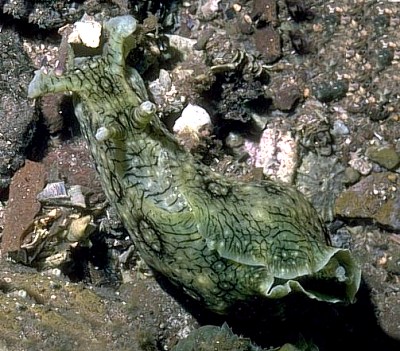
Aplysia dactylomela
Rang, 1828
Order: ANASPIDEA
Superfamily: APLYSIOIDEA
Family: Aplysiidae
DISTRIBUTION
Worldwide in tropical to warm temperate waters.
PHOTO
UPPER & LOWER LEFT: Long Reef, Sydney, New South Wales, Australia, December 1995, 12cm long alive. LOWER RIGHT: Koumac, New Caledonia, October 1993, 13cm long alive. Specimen showing colour variation with relatively thin black lines and rings. PHOTOS: Bill Rudman.
Characterised by relatively tough, leathery parapodia and large dark or black rings, and blackish reticulate lines. Black markings on both the outside and inside of the parapodia.
See Sea Hare - defence for a picture of A. dactylomela 'inking'. See also message below for a picture of an animal from the Bahamas.
See the General Topics List for more information on Sea Hares.
See Mating Chains
Reference:
• Rang, S. (1828). Histoire naturelle des Aplysiens, prèmiere famille de l'ordre des Tectibranches. 84pp., Plates 1-24. In: Férussac, D., Histoire naturelle generale et particuliere des Mollusques. Firmin Didot: Paris.
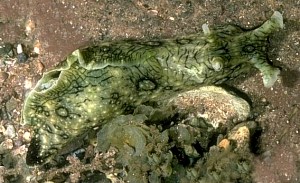

Rudman, W.B., 1999 (April 19) Aplysia dactylomela Rang, 1828. [In] Sea Slug Forum. Australian Museum, Sydney. Available from http://www.seaslugforum.net/find/aplydact
Related messages
Aplysia dactylomela from Canary Islands
March 3, 2010
From: Claudia Stoll
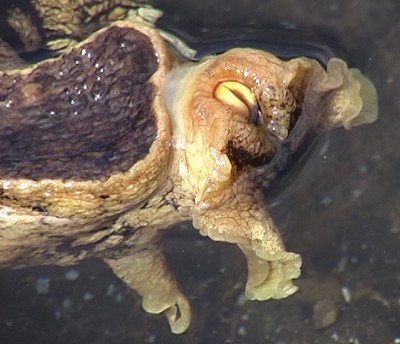
Dear Bill,
I have found a spezies of a seahare on the South-West-Coast of Teneriffe (24th of March, 2008) in a little pool on the rocks of Playa de la Arena.
I suspect, it is Aplysia dactylomela. The length of the animal was about 30cm.
And I was able to make a very nice video of the seahare! Here is the link to a little part of my video in youtube:
http://www.youtube.com/watch?v=vR5GGdBhC2k
Locality: Teneriffa, Playa de la arena, in a little pool on the beach/rocks, Spain, Canary Islands, Atlantic Ocean, 24. March 2008. Length: 30 cm. Photographer: Claudia Stoll.
And now my question is: Do you know, what the seahare is doing on this video? Is it eating? I need your help, because I`ll make a professional video film with underpin statements.
Thank you for your answer and best regards!
Claudia Stoll
from Germany
claudistoll@t-online.de
Stoll, C., 2010 (Mar 3) Aplysia dactylomela from Canary Islands. [Message in] Sea Slug Forum. Australian Museum, Sydney. Available from http://www.seaslugforum.net/find/23288Dear Claudia,
Snails and sea slugs often crawl upside down along the surface of pools. However the surface tension can only support reasonably small animals so large Sea Hares usually don't succeed. In a shallow pool like this your Sea Hare has its front half twisted upside down attempting to crawl along the surface of the pool while its back half is still on the bottom. In you video the mouth is going through its feeding movements. Often when small opisthobranchs are successfully crawling upside down in a pool their mouths rhythmically open and shut as though they are grazing. Whether they are attempting to graze or just 'going through the motions' I couldn't say, but as I have seen hydroid-feeding aeolids and sponge-feeding dorids doing it, I suspect it is just a reflex action.
However the water surface can be a good source of food. When the water is coming in after low tide we often find large amounts of dried organic matter floating on the water surface. Some intertidal brittle stars [ophiuroid echinoderms] feed almost exclusively by waving their arms over the surface to collect this dried organic material. It's possible your Sea Hare was doing the same, but it is unlikely, as they prefer red and brown macro algae.
Best wishes,
Bill Rudman
Aplysia dactylomela from Montego Bay, Jamaica
November 13, 2009
From: Semra Halabi
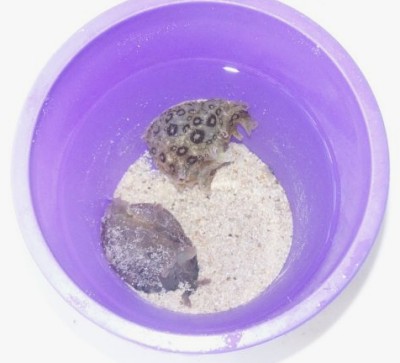
Hi i wonder if anyone could help us.
We have just got back from our holiday in Jamaica, One lovely morning while taking my baby down on the beach we came across the 2 things thinking they were jelly fish. I scooped them up in my babies bucket so my baby wouldn't get stung (they looked dead ) so i threw them back into the sea 10 minutes later they were back again so i scooped them back up and took them to my husband to show him what we found so he could go deeper near to the corals to release them later, my husband told me when he released them they grew double there size and looked like they had wings.
Locality: Montego bay, on the beach, Jamaica, 22 october 2009, clear water. Length: 1 - 2 inches. Photographer: Semra Halabi
Could any one tells us what they are and were they dangerous.
Thanks
Semra
semrahalabi@hotmail.com
Halabi, S., 2009 (Nov 13) Aplysia dactylomela from Montego Bay, Jamaica. [Message in] Sea Slug Forum. Australian Museum, Sydney. Available from http://www.seaslugforum.net/find/22774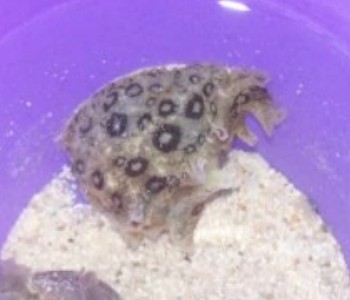
Dear Semra,
Your animal is a Sea Hare. Use the menu list on the top left of the page to have a look at the General Topics for a list of links to information on this group of sea slugs. You will see that Sea Hares ofte have wing-like flaps on the side of their bodies which in some species are used for swimming. Your species is Aplysia dactylomela, which has large black rings on its skin. These balck rings are particularly noticeable in Caribbean animals.
Sea Hares do not sting or bite, and so are essentially harmless. There is one large species in Western Australia, A. gigantea, which sometimes washes up on beaches. We don't know why, but dogs who bite these washed up sea hares can sometimes be badly poisoned, apparently by something in the slug's skin. However I know of no other reports around the world of a Sea Hare being blamed for anything untoward.
Best wishes,
Bill Rudman
Aplysia dactylomela from sthn Queensland
February 3, 2009
From: Gary Cobb
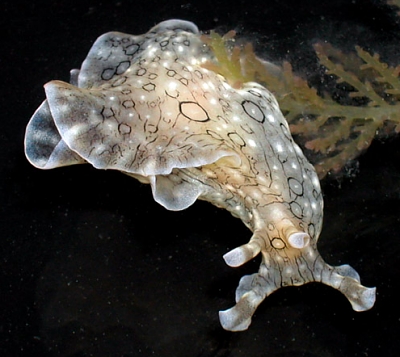
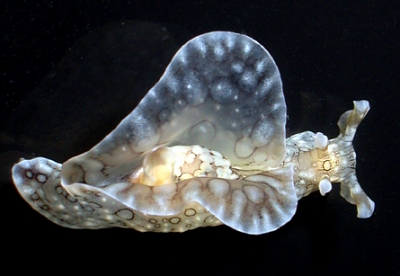
Concerning message #20921:
Hi Bill and everyone!
May I present to you a very pale version of Aplysia dactylomela found intertidal at Woody Point. The animal has very distinct rings and opaque white spots. When disturbed it would open it's parapodia wings but did not take flight. Interestingly when the wings were open exposing the shell, the area has raised white lumps which I have never seen before.
The body is somewhat translucent and there is no green colouration at all.
In the photos the animal is on the weed on which it was found.
Locality: Woody Point, Red Cliffe Peninsula, 100 mm, Queensland, Australia, Pacific Ocean, 12 August 2008, Intertidal. Length: 40 m. Photographer: David Mullins.
Cheers
Gary
gary@nudibranch.com.au
Cobb, G.C., 2009 (Feb 3) Aplysia dactylomela from sthn Queensland. [Message in] Sea Slug Forum. Australian Museum, Sydney. Available from http://www.seaslugforum.net/find/22212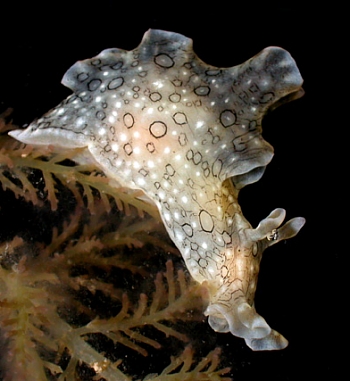
Dear Gary,
It is surprising to see a 10 cm long specimens of A. dactylomela with such a delicate 'look'. Usually by this size they have a more leathery and opaque appearance.
Best wishes,
Bill Rudman
Aplysia dactylomela? from South Africa
October 27, 2008
From: Daleen Loest
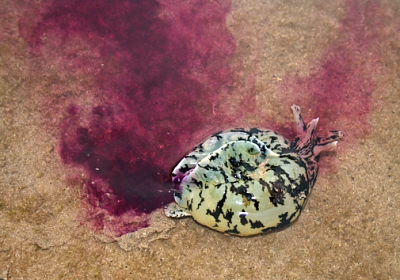
We have encountered this seaslug in a rockpool at under mentioned location.We have been vacationing here for the previous 20 years and this is the first time that we've seen them.The photo was taken when one was stranded on a rocky ledge as the tide receded.We gently placed it in the water whereupon it spurted out the bright pink ink.There were about 5 of them in these rockpools at any given time, accompanied by 3 other slugs whom have the same form and size, but was dappled with shades of brown.We've observed them continously for about 5 days whereafter we haven't seen them again.
Locality: East London,30 km south at Kidd's Beach, 10 cm to 50 cm, South Africa, Easter Cape Coast, Indian Ocean, 30 December 2005, rockpools, sandy bottom. Length: 10 cm. Photographer: Daleen Loest.
Daleen Loest
dloest@tiscali.co.za
Loest, D., 2008 (Oct 27) Aplysia dactylomela? from South Africa. [Message in] Sea Slug Forum. Australian Museum, Sydney. Available from http://www.seaslugforum.net/find/20536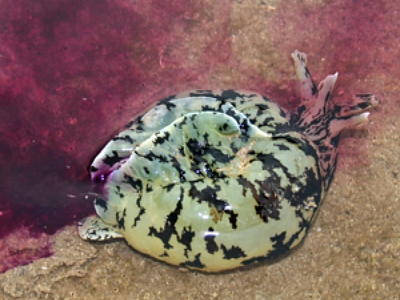
Dear Daleen,
If you look carefully at the enlarged photo alongside I hope you can see some very small black rings with a white centre in the dark grey patches. That would normally indicate that this is a color form of Aplysia oculifera which has tiny rings like this. However the parapodial flaps look thick, leathery, and are not very folded, which is quite unlike that species. I suspect this is an extreme colour form of Aplysia dactylomela. Both species occur in southern Africa and have a long history of being mixed up in South African publications, so I could just be joining the confusion, but in extreme colour forms of these two species I think the general body shape is a better indicator of identity than the size of the black rings.
If you want to know more about these animals, you will find a whole list of relevant pages, including one on their spectacular ink, under 'Sea Hares ' in the General Topics List.
Best wishes,
Bill Rudman
Re: Aplysia dactylomela from Canary Ids
October 21, 2008
From: Obdulia Cabrera Hernández
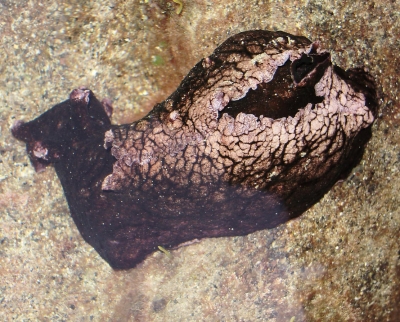
Concerning message #12448:
Could you help me, please? I have seen this Aplysia in the west coast of Fuerteventura, Canary Island, located in the intertidal rock pools, and would like to know the ID. Thanks
Locality: Fuerteventura, Canary Islands, intertidal rock pools, Spain, Atalntic Ocean, 15 Octuber 2008, Intertidal rock pools. Length: 12 cm. Photographer: Obdulia Cabrera Hernández.
Obdulia Cabrera Hernández
obdulia_ch@hotmail.com
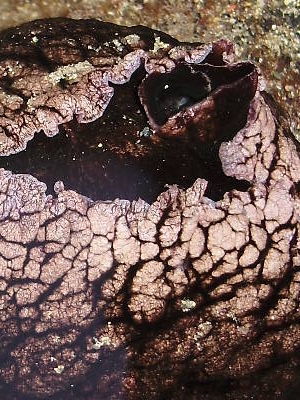
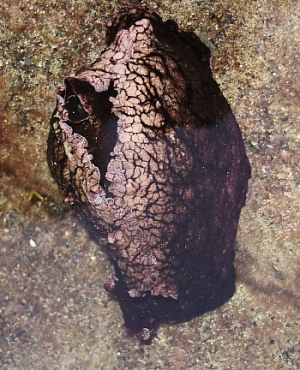
Dear Obdulia,
This is definitely a species of Aplysia but it is not a familar colour form. Although there are no real signs of black rings on it I suspect it is a dark form of Aplysia dactylomela. There are two or three records of this species from the Canary Islands on the Forum but none of them look quite like your animal. However since none of the other species of Aplysia recorded from the Canary Islands look like this either, I think we shoulf wait for some confirmation, or opinion, from someone familiar with this fauna
Best wishes,
Bill Rudman
Aplysia dactylomela egg masses from the Mediterranean
August 12, 2008
From: Antonello Greco
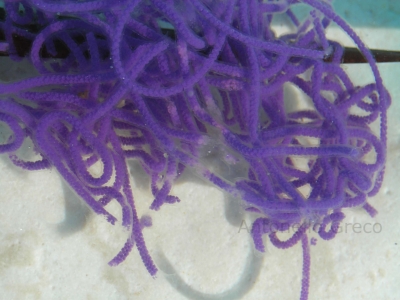
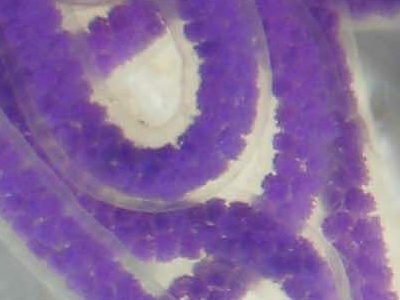
Dear Bill,
Concerning message #21693 about Aplysia dactylomela on your forum. As you know, two years ago I found a lot of specimens in Giardini Naxos (eastern Sicily) [message #17347 ] and wrote a paper about these findings (including the laying of the egg masses). Some months later I found some specimens in "Isola Bella", in Taormina, a few miles away from Giardini Naxos. Some days ago I found some specimens even in Syracuse 100 kilometers South of Giardini Naxos.
About the egg masses, several times I found them in the field even during the laying. I always found them purple color. I think it can depend on the diet.
I send you two attached photos.
- Greco A., 2006. Segnalazione di Aplysia dactylomela Rang, 1828 (Opisthobranchia: Aplysiidae) per il Mar Ionio (Sicilia orientale, Taormina). Bollettino Malacologico, 42 (9-12): 125-128.
Best wishes,
Antonello.
antonell78@hotmail.com
Greco, A., 2008 (Aug 12) Aplysia dactylomela egg masses from the Mediterranean. [Message in] Sea Slug Forum. Australian Museum, Sydney. Available from http://www.seaslugforum.net/find/21787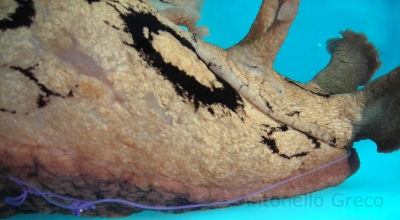
Dear Antonello,
Thanks for these photos. I think if I had seen this coloured eggs in the Indo-West Pacific I would have remembered. They are a spectacular colour. Even the pink-red eggs in Vinicius Padula's photos from Brazil [#21695] are quite unlike those from the Pacific I hope this sparks an interest in the topic. Just how multi-coloured are the eggs of Aplysia dactylomela and even allowing for colour change during development, do those from the Atlantic and the Indo-Pacific show a basic difference in colour?
Best wishes,
Bill Rudman
Re: Aplysia dactylomela and its egg-mass
July 10, 2008
From: Vinicius Padula
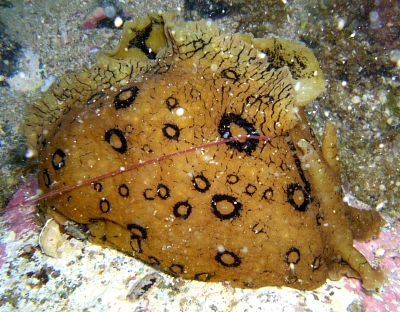
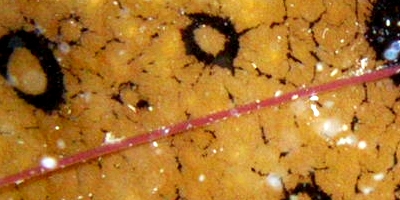
Concerning message #21693:
Dear Bill and Fabio,
I´m sending pictures of a Brazilian specimen of Aplysia dactylomela laying eggs. The eggs are pink/red, not purple. However, you can see in my other message [#21696 ] the variation of egg mass color of Aplysia fasciata.
I´m pretty sure that I have seen a purple Aplysia eggmass here, but I can´t find the picture.
Locality: Conchas Beach, intertidal, Rio de Janeiro, Brazil, Western Atlantic. Photographer: Vinicius Padula.
As Bill commented, the color change depends on the time of the development. However, it is interesting to check the these variations and also the size of the capsules, eggs, larvae etc.... I believe this can be very informative in these "species" with a wide geographic distribution.
Regards,
Vinicius
viniciuspadula@yahoo.com
Padula, V., 2008 (Jul 10) Re: Aplysia dactylomela and its egg-mass. [Message in] Sea Slug Forum. Australian Museum, Sydney. Available from http://www.seaslugforum.net/find/21695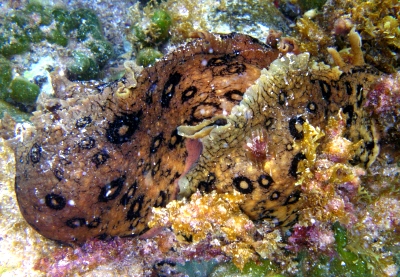
Thanks Vinicius,
It's funny how often it is the common things we never seem to record. When I think of how many Aplysia egg masses I have seen in the field and in aquaria, I have very few notes on the topic. I don't recall seeing pink/red or purple coloured eggs associated with A. dactylomela in the Pacific so it is certainly something we should take note of in the future.
As you say, size of eggs and type of development could give us valuable clues into whether these apparently circumglobal species are really one species or not. I am not so sure how much help colour will be but I guess until we get better information on the topic we will never know.
Best wishes,
Bill Rudman
Re: Aplysia dactylomela and its egg-mass
July 10, 2008
From: Fabio Crocetta
Concerning message #21693:
Yes Bill,
It is:
- Greco A., 2006. Segnalazione di Aplysia dactylomela Rang, 1828 (Opisthobranchia: Aplysiidae) per il Mar Ionio (Sicilia orientale, Taormina). Bollettino Malacologico, 42 (9-12): 125-128.
On the other hand after its first finding in Lampedusa (Trainito photobook -see message #14287) I've found another paper on the presence of Aplysia dactylomela in the Italian Seas that is:
-
Scuderi D. & Russo G.F., 2005. Prima segnalazione di Aplysia dactylomela Rang, 1828 e probabile presenza di Syphonota geographica (Adams & Reeve, 1850) (Gastropoda: Opisthobranchia: Anaspidea) per le acque del Mediterraneo. Biologia Marina Mediterranea, 12(1): 338-341.
But they don't report about egg masses.
Bye bye
Fabio
fabiocrocetta@alice.it
Crocetta, F., 2008 (Jul 10) Re: Aplysia dactylomela and its egg-mass. [Message in] Sea Slug Forum. Australian Museum, Sydney. Available from http://www.seaslugforum.net/find/21694Dear Fabio,
Thanks for the references. Records of Aplysia dactylomela from the Mediterranean were noted on the Forum in 2005, and the presence of Syphonota geographica three years earlier [message #8637]. It is good to add these references for background information.
Best wishes,
Bill Rudman
Re: Aplysia dactylomela and its egg-mass
July 9, 2008
From: Fabio Crocetta
Concerning message #12375:
Dear Bill,
Purple egg-masses of Aplysia dactylomela were also photographed and reported in a paper written by Antonello Greco about the record of Aplysia dactylomela at Giardini Naxos (Taormina, Italy). It's strange to see how the color of egg masses could be so variable:
purple [message #12375] and white [#18159]
A couple of sibling species? Or the colour of egg-masses in Aplysia spp. is not diagnostic?
Fabio Crocetta
fabiocrocetta@alice.it
Crocetta, F., 2008 (Jul 9) Re: Aplysia dactylomela and its egg-mass. [Message in] Sea Slug Forum. Australian Museum, Sydney. Available from http://www.seaslugforum.net/find/21693Dear Fabio,
I can find Antonello Greco's message on the Forum [#17347] but that doesn't mention a purple egg mass. It would be valuable if you could provide us with a full reference to the paper please.
Concerning egg colour in sea hares. The colour changes during the development of the eggs in a single egg mass [see Fact Sheet on Larval development in Aplysia oculifera]. In quite a few species the eggs are a pale yellow, cream or pink when they are deposited and darken in colour to orange-brown before hatching. I have also seen green eggs but never this bright purple colour. Perhaps someone else has observations to add? I have seen a lot of A. dactylomela eggs from the Indo-West Pacific but I am pretty sure I would have remembered seeing purple eggs. It would be interesting to know if anyone else has records of purple eggs from anywhere.
Best wishes,
Bill Rudman
Aplysia dactylomela from Rhodes, Greece
July 1, 2008
From: Adam Gill
Concerning message #21413:
Just back from Rhodes, Greece and in St Pauls Bay (near Lindos) I saw three Aplysia dactylomela in one day). First time I've seen them in the Med.
Locality: St Pauls Bay, Rhodes, 2 m, Greece, Mediterranean Sea, 29 June 2008, rocks and sand. Length: 25 cm
Adam Gill
adamgill22@hotmail.com
Gill. A., 2008 (Jul 1) Aplysia dactylomela from Rhodes, Greece. [Message in] Sea Slug Forum. Australian Museum, Sydney. Available from http://www.seaslugforum.net/find/21661Thanks Adam,
Yes it seems to be a very recent arrival in the Mediterranean
Best wishes,
Bill Rudman
Re: Aplysia dactylomela from the Canary Islands
March 6, 2008
From: Stanley Ramsell
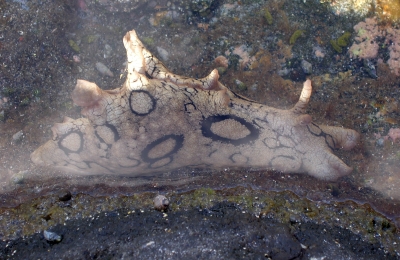
Concerning message #17374:
My wife and I went rock pooling while on holiday when close to the shore we saw two of these sea slugs which we found very interesting, we went back to the same place for a couple of days and they were still in the same spot. This is the first time we have seen a sea slug. Is it Aplysia dactylomela ?
Locality: Pueto Sanitago, Tenerife, Canary Islands, Atlantic Ocean, 28th Febuary, Clear Water, depth 30 cm. Length: 6 Inches. Photographer: Stanley Ramsell.
Stanley Ramsell
stan.ramsell@tesco.net
Ramsell,S, 2008 (Mar 6) Re: Aplysia dactylomela from the Canary Islands. [Message in] Sea Slug Forum. Australian Museum, Sydney. Available from http://www.seaslugforum.net/find/21413Dear Stan,
Thanks for the photo. I am glad you have found your first sea slug and I hope it won't be your last. Although this is quite a common Sea Hare its distribution around the world is quite intersting - and still a bit of a puzzle. It is common in the tropical Indian and Pacific Oceans and is also quite well known in the Caribbean and Atlantic Islands along the west coast of Africa. What is very surprising is that it had never been recorded from the Mediterranean until about 2002 [see message #14287]. Why did it take so long to get there and are the Mediterranean ones immigrants from the Atlantic or have they travelled through the Suez Canal as lessepsian migrants?
Best wishes,
Bill Rudman
Re: Sea hare from the Sunshine Coast, Queensland
October 10, 2007
From: Gary Cobb
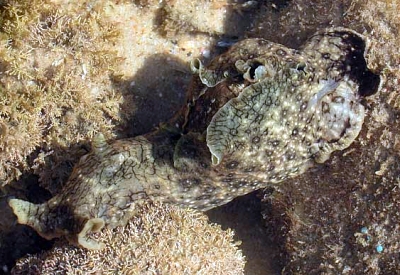
Concerning message #20861:
Hi Bill and everyone!
The Sea Hare that Aimee found is Aplysia dactylomela. It is the only large common Sea Hare I have found here on the Sunshine Coast. The telltale give away is the black tail.
Locality: Sunshine Coast near Mooloolaba, 100 mm, Queensland, Australia, Pacific Ocean, 09 October 2007, Intertidal. Length: 180 mm. Photographer: Gary Cobb.
Cheers
Gary Cobb
gary@nudibranch.com.au
Cobb, G.C., 2007 (Oct 10) Re: Sea hare from the Sunshine Coast, Queensland. [Message in] Sea Slug Forum. Australian Museum, Sydney. Available from http://www.seaslugforum.net/find/20921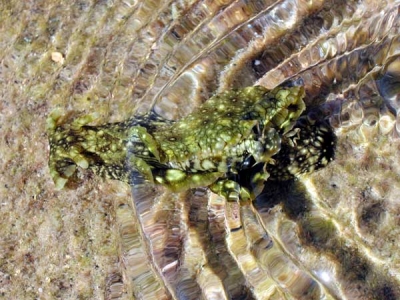
Thanks Gary,
There is not enough detail in Aimee's photos to be sure of the species, from the photos alone but I am sure from your local knowledge that you are right. We tend to think of large black rings when we mention A. dactylomela, but a quick look at earlier messages on the Forum, shows how the rings can be very small in some individuals. The black patch on the posterior part of the foot is a good indicator, if present, but it is not always present. Another character of A. dactylomela which distinguishes it from many other species, is that the body wall and parapodia are thicker - almost leathery to touch, rather than the thin and 'squashy' feel of most Aplysia.
I couldn't resist including your lower photo although it doesn't show much anatomical detail. It looks more like a dog swimming than a slow moving 'sluggish' sea hare. I guess the true interpretation is that it is holding on with grim determination as the current tries to wash it away
Best wishes,
Bill Rudman
Sea hare from the Sunshine Coast, Queensland
October 9, 2007
From: Aimee Richer

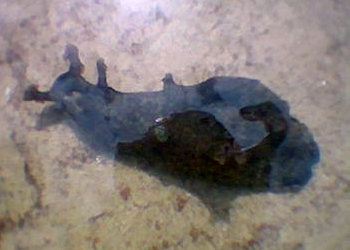
Hello, just wondering if anyone can tell me what type of sea slug this is? I saw it at the sunshine coast a couple of weeks ago. My dad thought it was a blue ringed octopus because of the markings and it has a dark Magenta ink.
Locality: Rock pool, Beach, 1 foot, Mooloolaba, QLD, 17 September 2007, Clear clean cool water. Length: 20cm. Photographer: Aimee.
Thanks,
A.
jetaimee1@hotmail.com
Richer, A.F., 2007 (Oct 9) Sea hare from the Sunshine Coast, Queensland. [Message in] Sea Slug Forum. Australian Museum, Sydney. Available from http://www.seaslugforum.net/find/20861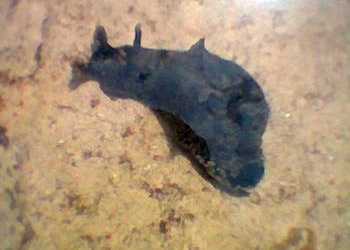
Note added 10 October 2007: This Aplysia dactylomela. See message #20921.
Dear Aimee,
I can't see enough in your photos to be sure what species you have found, but it is definitely a sea hare. If you go to the General Topics list on the menu bar at the top left side of the page, you will find a number of pages devoted to various aspects of sea hare natural history. For example you will find a page there on the purple ink they produce
Best wishes,
Bill Rudman
Aplysia dactylomela from the Canary Islands
September 28, 2007
From: Mikkel Andersen
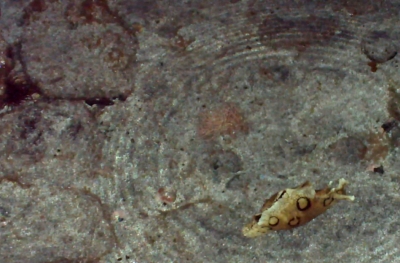
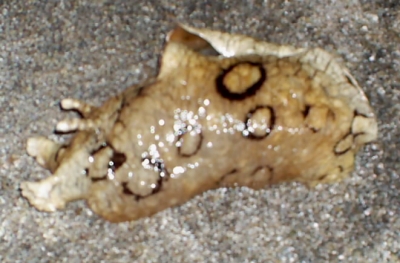
Hi..
I was walking along the rocky beaches of the Canary Islands when I came across this seaslug.. I have looked thru the species list, but have'nt been able to identify it..
Locality: Tenerife Sur, Canary Islands, 35 cm, Spain, Atlantic Ocean, 24 september 2007, Reef w/ sand. Length: 20 cm. Photographer: Mikkel Andersen.
Cheers,
Mikkel
mikkel@rigtigpirat.dk
Andersen, M. A. F., 2007 (Sep 28) Aplysia dactylomela from the Canary Islands. [Message in] Sea Slug Forum. Australian Museum, Sydney. Available from http://www.seaslugforum.net/find/20840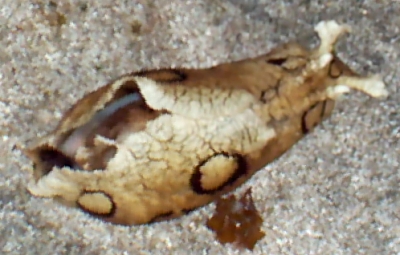
Dear Mikkel,
The large black rings are a sure sign that this is Aplysia dactylomela. Have a look at my comments [#16880] about an earlier find of this species from the Canary Islands.
Best wishes,
Bill Rudman
Aplysia brasiliana in eastern Mediterranean?
August 27, 2007
From: Gilbert Jaux
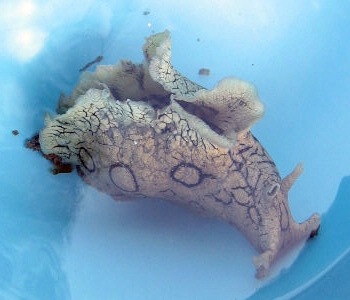
I think I have found Aplysia brasiliana while diving in Greece. I took these photographs because it is the first time that I have seen this this species. I have dived in this place for 30 years and I was astonished to see this Aplysia. Can you assure me that it is Aplysia brasiliana?
Locality: KALAMAKI, 2 metres, MESSINIAS - GREECE, MEDITERRANEE, 20 July 2007, Plongée en apnée. Length: 300 mm. Photographer: Gilbert JAUX.
Thank you
Gilbert Jaux
gilbert.jaux@wanadoo.fr
Jaux, G, 2007 (Aug 27) Aplysia brasiliana in eastern Mediterranean?. [Message in] Sea Slug Forum. Australian Museum, Sydney. Available from http://www.seaslugforum.net/find/20543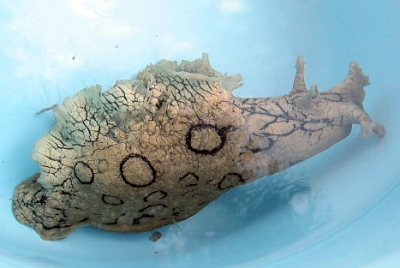
Dear Gilbert,
This is a sea hare, but it is Aplysia dactylomela which is a recent arrival into the Mediterranean. Have a look at the earlier messages on the Forum about this species in the Mediterranean. The puzzle is where did it came from? - the Atlantic or the Indian Ocean? and why has it taken until about 2002 for it to arrive there?
Best wishes,
Bill Rudman
Re: Feeding studies on Aplysia in Malaysia
July 20, 2007
From: Corvin Eidens
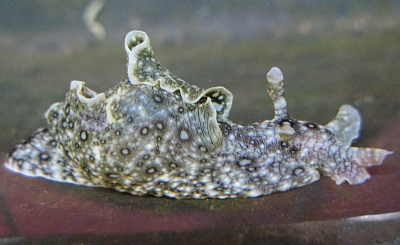
Concerning message #20078:
Some of the small ones are now almost 10 cm. We feed them with currently with Gracilaria. Do you know anyone who knows about Aplysia in Malaysia?
I found an egg mass two days ago and the Aplysia are mating a lot! Do they die after laying eggs? Can I raise them? I think it will be hard because of the planktonic larvae and the flow through system! And I need micro algae for feeding to them.
I tried to get in contact with Prof. Klussmann.Kolb from Germany. She wrote that nice article Phylogeny of the Aplysiidae (Gastropoda, Opisthobranchia) with new aspects of the evolution of seahares and hopefully she can may help me.
Here are some more pics!
Best wishes,
Corvin
corvin@eidens.de
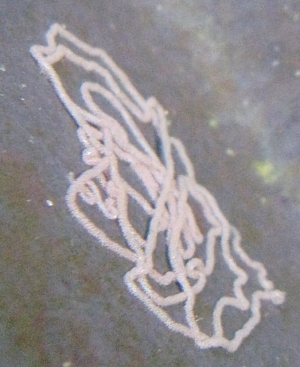

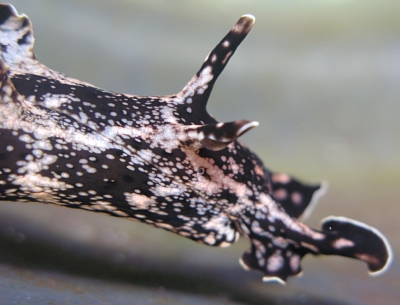
Dear Corvin,
The upper photo is clearly of Aplysia dactylomela. If it is a photo of one of the juveniles you sent photos of before, it is a nice demonstration of growth in the species. Aplysia dactylomela has a thicker more leathery skin than many other species, including A. oculifera, which was the reason I was not 100% sure they were all A. oculifera in your earlier message. What I am not sure about now is the bottom photo - is it a photo from before of one of the juvenile A. dactylomela or another species?
So you definitely have A. oculifera and A. dactylomela. Hopefully they are not interbreeding or my reputation will be destroyed! It's possible they will breed for weeks or even months, but eventually, probably within a year, they will die. I am sorry I can't suggest an expert on tropical species of Aplysia for you. I am sure Annette Klussmann-Kolb will help you if she can but I am not sure if her expertise extends to keeping generations alive in aquaria. All I know is that A. dactylomela seems to prefer partcular red algae [see message #9154]
Best wishes,
Bill Rudman
Aplysia dactylomela from Sabah, Malaysia
June 19, 2007
From: Richard Swann
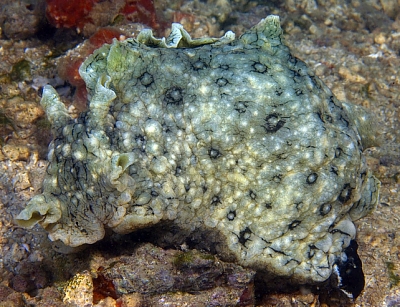
Hi Bill
I was looking through all the old posts on Aplysia dactylomela after finding what i think is one today and noticed that you have no records on the forum from my area.
Locality: Mamutik island,Kota Kinabalu, 9 meters, Sabah, Borneo, South China Sea, 04 June 2007, Sandy rubble slope, in current. Length: 25-30 cm. Photographer: Richard Swann.
I guess it is no surprise as i know their distribution is wide but still nice to have a confirmed sighting. We seldom see them here so i was over the moon when one turned up today. Sorry for the poor quality shots but my 105mm lens was not suited to this monster slug !
Best regards
Richard
www.downbelow.co.uk
richard@downbelow.co.uk
Swann, R., 2007 (Jun 19) Aplysia dactylomela from Sabah, Malaysia. [Message in] Sea Slug Forum. Australian Museum, Sydney. Available from http://www.seaslugforum.net/find/19986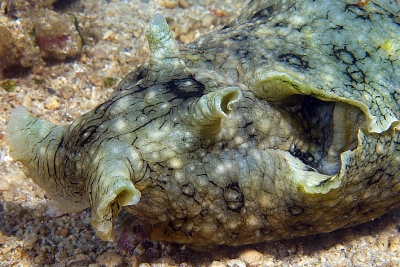
Dear Richard,
Although the black rings are quite small for this species, there is no mistaking it for anything else. I suspect the reason we don't have good photos of many large Sea Hares is that sea slug fanciers use 105 mm lenses or something similar. I guess you should buddy with a fish photographer - but as a rule they tend to get bored quite quickly if you spend too much time at one spot looking for small things
Best wishes,
Bill Rudman
Big sea hares on Mexican beach
April 2, 2007
From: Benjamin Fisher
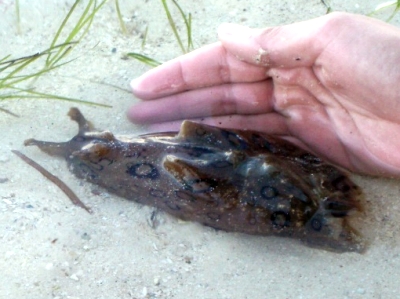
My girlfriend and I were vacationing in Cozumel, which is an island off the Yucatan Peninsula of Mexico. We were walking on the beach, where an estuary lets out into a salty lagoon connected to the ocean. We noticed 4 sea hares washed up on the beach that were still alive but obviously dying. They were about 15 cm long and 5 cm wide. They had an olive green colour with black circles about 1 cm wide randomly placed on their surface. They secreted purple ink when touched. Flaps af skin partly folded over their back but did not cover what appeared to be feathery gills on their back like a nudibranch (seen laying to the side of lower image). Their underside faded into a darker rust colour. The water they were in was calm like a lake and there were no storms that week that might have washed them up. Do you know what they are and why they were on the beach?
Locality: North side of Cozumel Island, 1-2 cm, Quintana Roo, Mexico, Caribbean, 22 March 2007, Intertidal mangrove discharge, sandy with some grass. Length: 15 cm. Photographer: Ben Fisher.
Ben Fisher
spinycheek@hotmail.com
Fisher, B.A., 2007 (Apr 2) Big sea hares on Mexican beach. [Message in] Sea Slug Forum. Australian Museum, Sydney. Available from http://www.seaslugforum.net/find/19788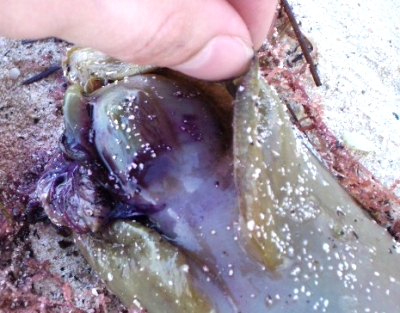
Dear Ben,
This is Aplysia dactylomela. It's often difficult to know why animals like this are dying, but at 15 cm, they are probably reaching 'old age'. Another possibility, in shallow lagoonal situations like this, is that high temperatures and shallow water can warm the water up and lower the oxygen available - but both ideas are just guesses. If you look at the General Topics List you will find a section on sea hares. Have a look there for more information on Sea Hares including a page on the mantle cavity and gills etc.
Best wishes,
Bill Rudman
Re: Feeding preference of Aplysia dactylomela
November 27, 2006
From: Baki Yokes
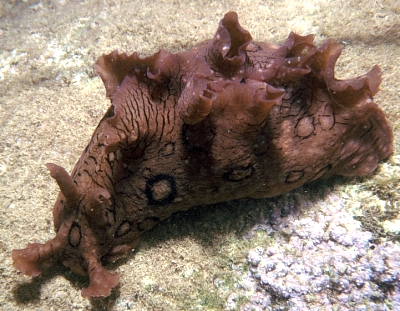
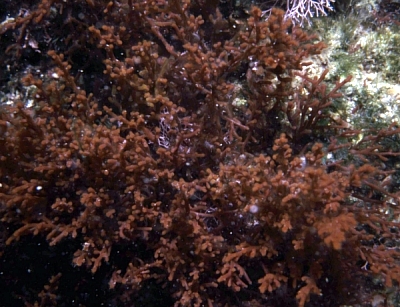
Concerning message #5517:
Dear Bill and Patricia,
I found a chance to examine what Aplysia dactylomela is eating in the Mediterranean. On Eastern Mediterranean coast of Turkey we have an established population now. Most of them are dark red in colour, most probably due to the red alga, Laurencia sp.(Rhodomelaceae, Rhodophyta), which constitutes the main part of their diet.
Locality: Iskenderun, 1 m, Turkey, Mediterranean Sea, 2 November 2005, Rocky. Length: 18-20 cm. Photographer: Baki Yokes.
I have published a paper about the Turkish records
- Yokes, M.B. (2006) Aplysia dactylomela: an alien opisthobranch in the Mediterranean. JMBA2 - Biodiversity Records. Published online
which is available at the following address.
http://www.mba.ac.uk/jmba/pdf/5299.pdf
Best wishes
Baki
bakiyokes@turk.net
Yokes, M.B., 2006 (Nov 27) Re: Feeding preference of Aplysia dactylomela. [Message in] Sea Slug Forum. Australian Museum, Sydney. Available from http://www.seaslugforum.net/find/18567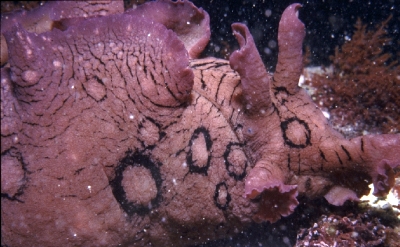
Dear Baki,
Thanks for the reference. Your animals certainly have a pinkish tinge. It would be interesting to konw what would happen if you fed some solely on Ulva or Enteromorpha. If they lost their pinkish tinge and and became a more typical white colour, it would suggest they are taking up some of the red algal pigments.
Best wishes,
Bill Rudman
Re: Feeding preference of Aplysia dactylomela
November 20, 2006
From: Philibert Bidgrain
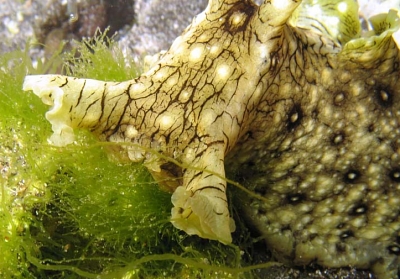
Concerning message #5517:
Dear Bill,
Reunion Island sea slugs.
I found a population of about 10 to 30 Aplysia dactylomela in a lagoon on beach rock. They feed voraciously on this filamentous green algae.
Locality: Saint Gilles, 10 cm, Reunion Island, Indian ocean, 7 november 2006, lagoon. Length: 15 cm. Photographer: Philibert Bidgrain.
All the best
Philibert Bidgrain
http://vieoceane.free.fr/runseaslug/indexslug.htm
pbidgrain@yahoo.fr
Bidgrain, P., 2006 (Nov 20) Re: Feeding preference of Aplysia dactylomela. [Message in] Sea Slug Forum. Australian Museum, Sydney. Available from http://www.seaslugforum.net/find/18376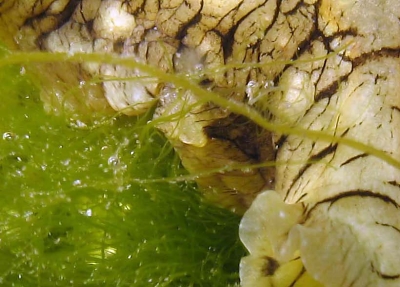
Dear Philibert,
It's intersting looking through the earlier messages on this species. Although I have noted various scientific studies suggesting it prefers red algae, there are also observations of it eating the green algae Ulva (sea lettuce) and green 'hair algae '. I would identify your filamentous green algae as Enteromorpha, which is closely related to Ulva. In fact I just read somewhere that some authors consider Enteromorpha to be a filamentous form of Ulva. So as I said in answer to an earlier message, Ulva or Enteromorpha would be a good food for this Aplysia in home aquaria. One side effect of eating only green algae would be that the sea hare would lose its ability to produce its red ink, the pigment of which is derived from red algae.
Best wishes,
Bill Rudman
Aplysia dactylomela - eggs and larvae
November 6, 2006
From: Jacob, Tim & Mai
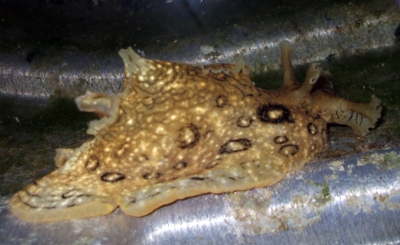
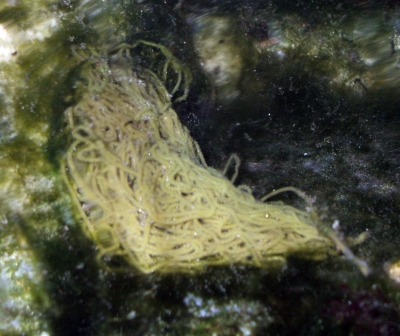
I have 2 sea hares (Aplysia sp.) in my 300 gallon set up, and one of them has layed a mass of eggs right under the over flow from the filter, which I think is very interesting because the eggs will get constant cleaned and oxegonated water, The Sea hare has layed the eggs on the morning of Oct-28-2006, and I don't know how long it will take them to hatch... I know that they will first be free floating larvae and feed in micro algae and micro organisms before they metamorphose into the sea hare they are... Do you know how long it will take for the eggs to hatch?
Locality: Palm Beach, 4 to 8 feet, Florida USA, Atlantic, 29 October 2006, rocky reef in Lantana Beach. Length: 7 inches. Photographer: Mai G..
Jacob G.
GSMai@aol.com
Jacob, Tim & Mai, 2006 (Nov 6) Aplysia dactylomela - eggs and larvae. [Message in] Sea Slug Forum. Australian Museum, Sydney. Available from http://www.seaslugforum.net/find/18159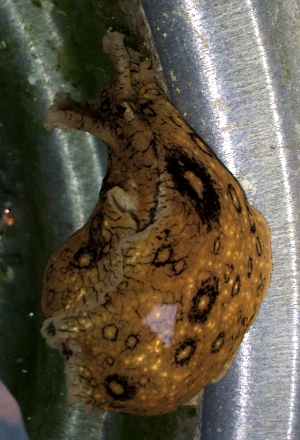
Dear Jacob,
Youe sea hare is Aplysia dactylomela. Have a look at an earlier message about keeping this species in aquaria [#14764]. They will probbaly take 10 -20 days to hatch, but the big problem is keeping the free swimming larvae alive and healthy. The phytoplankton they feed on are not usually present in aquaria, and getting the right plankton species and keeping them alive is a specialised task.
Best wishes,
Bill Rudman
Aplysia dactylomela from Croatia
August 28, 2006
From: Tom Turk
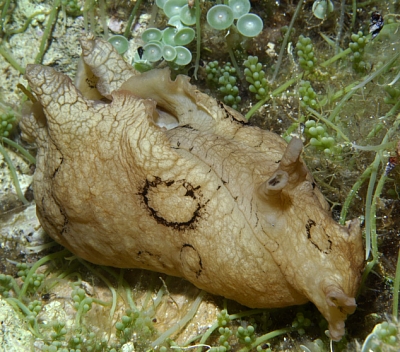
Dear Bill,
Here is a photo of Aplysia dactylomela taken on a day dive on the rocky bottom covered with algae at the depth of approx 10 m. Location island Susac, Croatia, Adriatic sea. It is interesting that the specimen was found crawling over the Caulerpa racemosa also a lessepsian species in Mediterranean. Is it possible that the slug actually feed on Caulerpa?
Locality: Island Sušac, Adriatic sea, 10-12 m, Croatia, Adriatic, July, 2006, rocky gottom covered with algae. Length: 5, 8 and 20 cm. Photographer: Borut Furlan.
Best regards,
Tom Turk
tom.turk@bf.uni-lj.si
Turk, T., 2006 (Aug 28) Aplysia dactylomela from Croatia. [Message in] Sea Slug Forum. Australian Museum, Sydney. Available from http://www.seaslugforum.net/find/17598Dear Tom,
As I have mentioned in earlier messages I am not sure whether A. dactylomela is a lessepsian species or a late arrival from the Atlantic. Considering it has been known from the Canary Islands for many years, an Atlantic origin would seems as likely as an Indian Ocean origin.
Concerning feeding on Caulerpa. I don't know of any records of any species of Aplysia feeding on Caulerpa and considering the vast beds of various Caulerpa species which occur in various parts of the world, I would have thought someone would have noticed, especially when some Caulerpa have become pests.
Best wishes,
Bill Rudman
Aplysia dactylomela from the Canary Islands
August 21, 2006
From: Christian Kowalewski
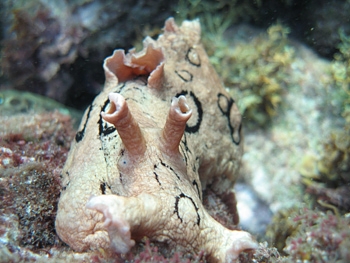
Hallo,
Aplysia dactylomela seems to be quite common here on Tenerife Island in the first 5 meters of depth. In this shallow sublittoral region it is often found on rocky terrain with a lot of different algae. I saw around 20 specimens all about 15 cm long, and this seems to be a usual occurrence.
Locality: Tenerife Island, Canary Islands, 3 meters, Spain, Atlantic Ocean, 03 May 2006, below intertidal zone, rocky but overgrown. Length: 15 cm. Photographer: Christian Kowalewski.
The other day I saw a curious thing - it looked like an Aplysia dactylomela copulating with a A. fasciata, but I couldn't take any picture because of the waves.
Thanks
Christian Kowalewski
moratorix@gmx.de
Kowalewski, C J, 2006 (Aug 21) Aplysia dactylomela from the Canary Islands. [Message in] Sea Slug Forum. Australian Museum, Sydney. Available from http://www.seaslugforum.net/find/17374Thanks Christian,
When I commented on your Micromelo undata [message #17376] being one of those species which is found very close to the Mediterranean and yet not quite getting there, I also had A. dactylomela in mind. Until a few years ago A. dactylomela had never been reported from the Mediterranean, but now we regularly have sightings reported on the Forum from as far east as Turkey. It is certainly a puzzle why the species has apparently just arrived in the Mediterranean - and did it come from the Indian Ocean, via the Suez Canal, or from the Atlantic - perhaps from the Canary Islands?
Best wishes,
Bill Rudman
Re: Aplysia dactylomela in Eastern Sicily
August 18, 2006
From: Andrea Corso
Concerning message #17357:
Just a few days ago in Crete, at Elounda and at Gavromous Bay, I saw a few individuals of this species
Andrea Corso
voloerrante@yahoo.it
Corso, A., 2006 (Aug 18) Re: Aplysia dactylomela in Eastern Sicily. [Message in] Sea Slug Forum. Australian Museum, Sydney. Available from http://www.seaslugforum.net/find/17498Thanks Andrea,
Best wishes,
Bill Rudman
Aplysia dactylomela in Eastern Sicily
August 7, 2006
From: Agatino Reitano

I saw eight specimens of Aplysia dactylomela when snorkeling in the Giardini Naxos Bay, very close to Taormina bay (Eastern Sicily, Messina).
All specimens were together into a fracture of a white rock. All specimens were yellow with black "eyes" on both side, only one with dark color.
Locality: Giardini Naxos, Messina, 1,5 meters, Sicily, Mediterranean sea, 04 august 2006, On rocks. Length: 20,30 cm. Photographer: Agatino Reitano.
Agatino Reitano
tinohawk@yahoo.it
Reitano, A., 2006 (Aug 7) Aplysia dactylomela in Eastern Sicily. [Message in] Sea Slug Forum. Australian Museum, Sydney. Available from http://www.seaslugforum.net/find/17357Dear Agatino,
Thanks for this record. By chance I am posting another message today [#17347] of a recent sighting of A. dactyomela in Giardini Naxos Bay.
Best wishes,
Bill Rudman
Aplysia dactylomela in Sicily
August 7, 2006
From: Antonello Greco
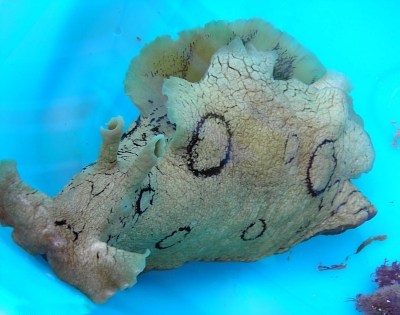
On the eastern coast of Sicily (Giardini Naxos) I recently found a specimen of Aplysia dactylomela, an alien species for Mediterranean Sea. After some days I found two other specimens of the same species. I found all of them in rocky substrates, covered by red algae (Corallina sp, Jania sp., Peyssonnelia sp), in shallow water (-1/-2 m.).
Locality: Giardini Naxos, Sicily, -2 m, Italy, Mediterranean Sea, 24 July 2006, rocky substrate. Length: 20 cm. Photographer: Antonello Greco.
The three specimens makes me think they were not occasional findings. So I collected some information about the biology of the species. I took some photos and some videos about the specimens I found, to document the finding. I also wrote a scientific article, hoping that it can be published as the first record for the Italian coasts. I think alien species should be monitored, because of the ecological consequences they could bring in places different from theirs.
Dr. Antonello Greco
antonell78@hotmail.com
Greco, A., 2006 (Aug 7) Aplysia dactylomela in Sicily. [Message in] Sea Slug Forum. Australian Museum, Sydney. Available from http://www.seaslugforum.net/find/17347Dear Antonello,
Thanks for another record from the Mediterranean. If you have a look at the earlier messages on this species on the Forum [see Fact Sheet] you woll see we have quite a few Mediterranean records now, mostly from the eastern end, but the first record I know of was in Egidio Trainito's book where he photographed it at Lampedusa Island [between Malta and Tunisia] in 2002. The interesting puzzle is not so much how it got into the Meditteranean, but why it took so long getting there? It is a well known inhabitant of the Caribbean and has been reported long ago from the Canary Islands.
Best wishes,
Bill Rudman
Aplysia dactylomela in Crete, Greece
August 4, 2006
From: Stig & Sus Andersson
When snorkelling in Greece, we saw this fascinating creature that we now, thanks to this website, have identified as Aplysia dactylomela. There were 2 sea hares, one climbing over the other (probably copulating).
Locality: The small harbour/beach in Stavros, north-north-east of Chania, 3 meters, Chania, Crete, Greece, Mediterranean, 29 July 2006, Sand. Length: 20-30 cm
Since this species, according to previous messages, has only newly been reported from the Mediterranean, we thought it might be good to give another report of location. Unfortunately there was no picture left in our underwater camera when we discovered them, so I have no pictures.
Stig & Sus Andersson
Sweden
Stig.Andersson@farad.se
Andersson, S, 2006 (Aug 4) Aplysia dactylomela in Crete, Greece. [Message in] Sea Slug Forum. Australian Museum, Sydney. Available from http://www.seaslugforum.net/find/17324Dear Stig & Sus,
Thanks for the record.
Best wishes,
Bill Rudman
Aplysia dactylomela from the Canary Islands
June 15, 2006
From: Paul Harwood
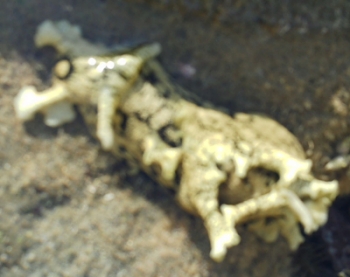
Whilst holidaying on Gran Canaria I saw several of these lovely little creatures patrolling the rock pools and low tide. I have searched the internet but have been unable to find out what they are
Locality: Beach, Gran Canaria, Canary Islands, Atlantic, 25 May 2006, rock pool. Length: 100 mm. Photographer: Paul Harwood
Paul Harwood
paul.harwood@wspgroup.com
Harwood, P, 2006 (Jun 15) Aplysia dactylomela from the Canary Islands. [Message in] Sea Slug Forum. Australian Museum, Sydney. Available from http://www.seaslugforum.net/find/16880Dear Paul,
This is the Sea Hare, Aplysia dactylomela. Have a look at the species fact Sheet and the accompanying messages for more information about the species. Have a look at the Sea Hare Fact Sheet for more information and links on Sea Hares.
Aplysia dactylomela is a very distinctively coloured species, with its black rings, and is found in both the tropical Indo-West Pacific and the tropical Atlantic, especially the Caribbean.. It was reported from the Canary Islands in 1932 (Odhner, 1932) [see also message #9979] and has long been known from the west coast of Africa. In fact it was first described from Cape Verde Islands by Rang in 1828. What is very surprising is that until very recently it had never been reported from the Mediterranean [see message #14287 ].
Best wishes,
Bill Rudman
Aplysia dactylomela from Florida
April 13, 2006
From: Rose Ann Maly
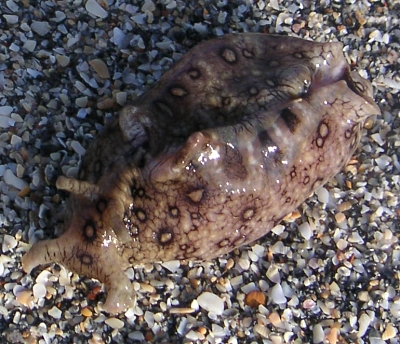
Please be so kind to tell me what sort of creature I found on the beach that looks like a jellied toy football.
Locality: Singer Island, on beach, Florida, USA, Atlantic, 3 April 2006, sandy beach adjacent to Anastasia reef. Length: 8-10 inches long. Photographer: r. a. maly.
Rose Ann Maly
ram@ramaly.com
Maly, R.A., 2006 (Apr 13) Aplysia dactylomela from Florida. [Message in] Sea Slug Forum. Australian Museum, Sydney. Available from http://www.seaslugforum.net/find/16309Dear Roseann,
This is a Sea Hare called Aplysia dactylomela. This, to my knowledge is not a swimming species, but there are two swimming Sea Hares, A. morio and A. brasiliana which appear to be quite common in Florida at present.. Have a look at the Fact Sheets and attached messages for photos and information on those species. A. dactyomela is very recognisable from the large dark blackish rings on the body.
Best wishes,
Bill Rudman
Aplysia dactylomela from Greece
February 27, 2006
From: Maria Salomidi
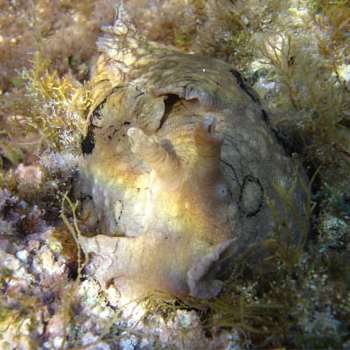
Concerning message #15107:
Hi. I found this Aplysia this January in Rhodos Island, Aegean Sea, Greece. I teased it a bit and it inked a deep purple. Browsing in your forum it struck me that it seems very much like an Aplysia extraordinaria.
Locality: Rhodos Island, 1metre, Greece, Mediterranean. Aegean Sea, 20 January 2006, rocky subtidal with photophilic vegetation. Length: about 25cm. Photographer: Maria Salomidi .
What do you think? Are there any records from it in Greece?
Thank you in advance.
Maria Salomidi
msal@hcmr.gr
Salomidi M., 2006 (Feb 27) Aplysia dactylomela from Greece. [Message in] Sea Slug Forum. Australian Museum, Sydney. Available from http://www.seaslugforum.net/find/15942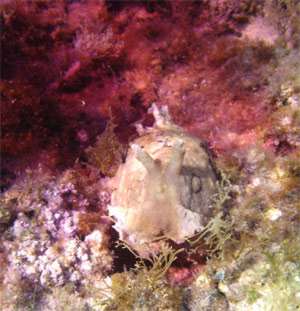
Dear Maria,
Your animal is a sea hare, but it is Aplysia dactylomela, a species characterised by the black rings on its body. As you will see if you look at some of the earlier messages on this species [attached to Fact Sheet], this species has only recently been reported from the Mediterranean.
Best wishes,
Bill Rudman
Aplysia dactylomela from Cyprus
October 17, 2005
From: Samantha Cooke
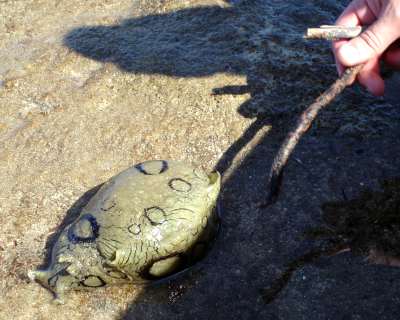
hello
I'm not a big fan of things under the sea but I was keen to identify a squidgy thing I found in a beach in akrotiri cyprus. I think your site has helped me to do that although my slug is a different colour to yours it look very similar. Is it Aplysia dactylomela. I wouldn't mind learning more about it if you have some info.
Locality: Akrotiri, Cyprus. Mediterranean. on beach. Length: approx 8 inches. 30 september 05. sandy, crystal clear water. Photographer: Samantha Cooke
Thank you
Samantha Cooke
leicstiger@hotmail.com
Cooke, S., 2005 (Oct 17) Aplysia dactylomela from Cyprus. [Message in] Sea Slug Forum. Australian Museum, Sydney. Available from http://www.seaslugforum.net/find/15021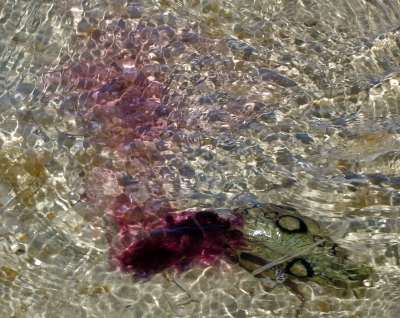
Dear Sammy,
This is indeed Aplysia dactylomela. As you will see from other messages on the Forum [see message #14305] we now have a number of records of this species from Turkey, Greece and Cyprus, suggesting this is a recent arrival in the Mediterranean. As it is found in both the Atlantic and the Indo-Pacific, I can't really say whether it is a Lessepsian migrant through the Suez Canal or a late arrival from the Atlantic.
For more information on this species, have a look at the other messages attached to the bottom of the Fact Sheet. There is a lot of information spread through them. For more general information on Sea Hares see the link to Sea Hares in the General Topics List. As you will see there, producing purple ink is characteristic of many Sea Hares.
Best wishes,
Bill Rudman
Aplysia dactylomela - keeping in aquarium
September 16, 2005
From: Jack Brown
Greetings from Alaska the Greatland.
Our local fish store has been selling the Sea Hare - Aplysia dactylomela for the past few years. They don't have any knowledge on how to feed it after it has cleaned up all the green hair algae in your home aquarium. They sell several per week because they do such an incredible job of cleaning up green hair algae. I know others have asked this question.... How can I supplement the diet of the sea hare? I've tried sheet algae and colerpa with negative results. I also believe that my large cleaner shrimp is severely stressing the sea hare by 'digging' at its back all the time. I really hate to see this creature in a constant slow death scenario... Any suggestions?
Jack Brown
Anchorage
Alaska, USA
jackandsue@gci.net
Brown, J., 2005 (Sep 16) Aplysia dactylomela - keeping in aquarium. [Message in] Sea Slug Forum. Australian Museum, Sydney. Available from http://www.seaslugforum.net/find/14764Dear Jack,
In an earlier message [#9154] I referred to research that suggested that this species of sea hare preferred to eat particular red algae. But if it eats green 'hair algae' it obviously can survive on other algae. One report showed they would eat the green alga Ulva, commonly called Sea Lettuce, which may be what you call sheet algae? They do grow a little on Ulva but clearly it's not their preferred food. This is a problem in small aquaria, because red algae tend to produce some very nasty waste products which can poison the water. Only other suggestion would be to grow a tank of hair algae to feed the Aplysia.
Concerning the cleaner shrimp. All I can suggest is moving it to another tank
Best wishes,
Bill Rudman
Aplysia dactylomela 'infant' from Bahamas
August 27, 2005
From: Anne DuPont
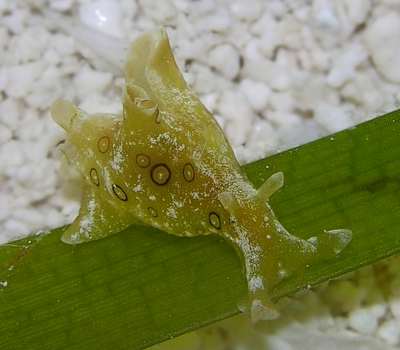
Dear Bill,
I thought you might enjoy seeing an Aplysia dactylomela "infant". I found this tiny one on sea grass (Thalassia testudinum) in a sandy patch. It's size was approximately 9 mm. The photograph was taken on February 22, 2005 in approximately 6 feet of water near Stocking Island, Exumas, Bahamas. This was the smallest one I found. I did find three others that were larger, 20 mm, 25 mm and 30 mm. They were found in algae (Batophora oerstedii ).
Cordially,
Anne DuPont
Delray Beach, FL
akdupont@bellsouth.net
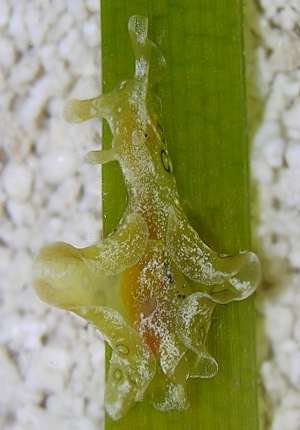
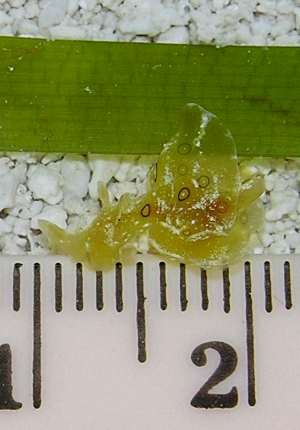
Dear Anne,
It's nice to know that at least one species of Aplysia is so easy to identify even as a juvenile. The black rings are a dead giveaway. It's interesting that at this small size it has adult body proportions. The only hint I can see that it is a juvenile, other than its size, is the quite large foramen through which the shell can be seen [see Sea hare mantle cavity]. In adult specimens of this species the foramen is usually tightly closed.
Best wishes,
Bill Rudman
Another record of Aplysia dactylomela from Greece
August 11, 2005
From: Allan David
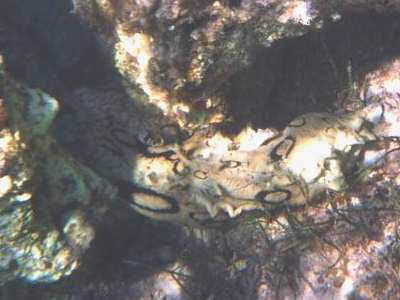
Concerning records of Aplysia dactylomela from Greece [message #14453 ]:
Whilst snorkeling off Stoupa Greece I saw this large slug between two rocks that was the first time,after that I saw another two at varying times, in different parts of the beach.
Locality: Stoupa, Greece, Ionian Sea. Depth: 1 M. Length: 200 mm. 13 - 17 July 2005. Rock & sandy bottom. Photographer: Allan David
Allan David
allandavid@supanet.com
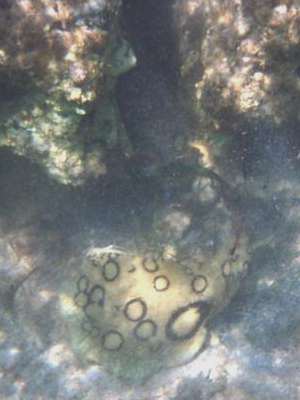
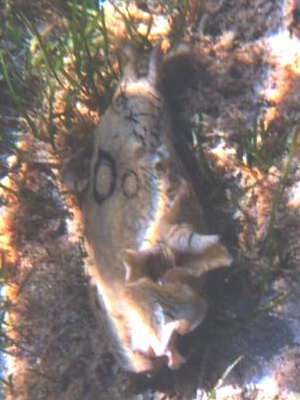
Dear Allan,
Thanks for this sighting. It certainly appears that this species has arrived in the Mediterranean very recently. From the quick response from 'non-experts', it would seem to me that if A. dactylomela had been present in the fauna for any length of time, one of the many 'experts' in the region would have notice it.
Best wishes,
Bill Rudman
Re: Aplysia dactylomela in the Eastern Mediterranean
August 1, 2005
From: Christopher Sweeting
This may perhaps be of interest in this discussion [message #14287] about Aplysia dactylomela from Greece.
I have just returned from my holiday in Rhodes, Greece and have been searching out the identity of a sea hare I spotted snorkelling. I came across the photographs included on these pages (unfortunately i have none of my own to add) which provide an excellent match.
The specimen I observed was measured rather unscientifically by a foot placed close by followed by restrospective measurement of the foot. I sized it at 28cm. If anyone has any contacts in the area I can give an accurate description of where I found it down to a few metres.
Locality: St Paul's Bay, Lindos, Greece. Mediterranean. Depth: 1-3 m. Length: 28 cm. 15 - 20th July 2005. lightly vegetated rock wall.
Christopher Sweeting
christopher.sweeting@ncl.ac.uk
Sweeting, C., 2005 (Aug 1) Re: Aplysia dactylomela in the Eastern Mediterranean. [Message in] Sea Slug Forum. Australian Museum, Sydney. Available from http://www.seaslugforum.net/find/14453Dear Chris,
Thanks for the record. It certainly seems to be a recnet arrival in the Mediterranean
Best wishes,
Bill Rudman
Aplysia dactylomela in the Eastern Mediterranean
July 21, 2005
From: Baki Yokes
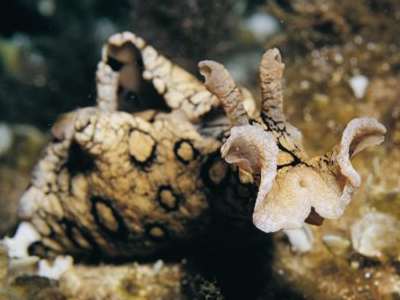
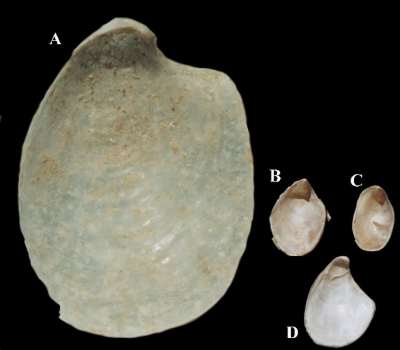
Dear Bill,
Concerning the message [#14287] about Aplysia dactylomela from Greece. If you remember, about a year ago we have been discussing about the identity of a big, white and highly calcified Aplysid shell which I had found in Antalya, Turkey, and the possibility of its being Aplysia dactylomela. The shell is very big compared to other Mediterranean species. I have not yet found a live individual yet, except just a few more shell fragments, but my cousin has photographed this species on a night dive in northern Cyprus. When the photos from Lampedusa and Greece are taken into consideration, it seems that, although it is rare, this species may show a wide distribution in the Eastern Mediterranean.
Locality [of live animals]: Girne, Northern Cyprus. Depth: 7 m. Length: about 20 cm. July 2004. Rocky substrate. Photographer: Fehmi Senok
Shell photos data:
A- Aplysia dactylomela shell: 30.75 mm, animal:??
B- Aplysia fasciata shell:7.25 mm, animal: 2.2cm
C- Aplysia parvulashell: 5.65 mm, animal: 3.4cm
D- Unidentified Aplysia sp. shell: 7.55 mm, animal: 6.5 cm
all of them were collected in Antalya, Turkey
Best wishes
BakiYokes
bakiyokes@turk.net
Yokes, M.B., 2005 (Jul 21) Aplysia dactylomela in the Eastern Mediterranean. [Message in] Sea Slug Forum. Australian Museum, Sydney. Available from http://www.seaslugforum.net/find/14305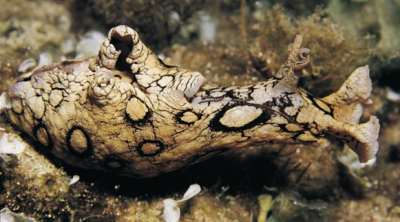
Dear Baki,
Thanks for these photos. It certainly seems Aplysia dactylomela has arrived in the Mediterranean. I can't find any earlier Mediterranean records, and considering its unmistakeable colouring, it would surely have been noticed earlier if present. The pale colour pattern of the three records from the Mediterranean are similar to those of Atlantic specimens, so I guess their origin is more likely to be from the Atlantic than through the Suez Canal - but why now?
Best wishes,
Bill Rudman
Aplysia dactylomela from Greece
July 20, 2005
From: Lucyna Sterniuk-Gronek
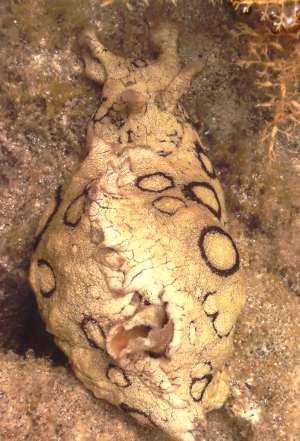
Hallo!
What a splendid animal! When I found it on Rhodos I thought that it was a visitor from the cosmos :)
Fortunately I found also your great site and was able to identify it as Aplysia dactylomela!
Locality: Rhodos, Greece, Aegean Sea. Depth: 10 cm. Length: 20 cm. 19 June 2005. Photographer: Lucyna Sterniuk-Gronek
I send you some photos and greetings!
Lucyna Sterniuk - Gronek (from Poland)
ps. Are there any sea slugs in our cold Baltic Sea?
lelix@poczta.onet.pl
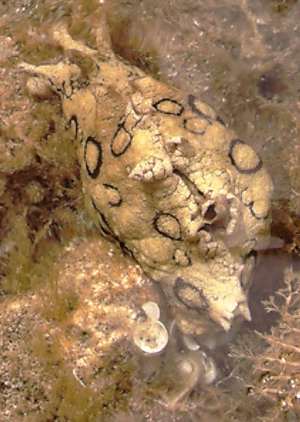
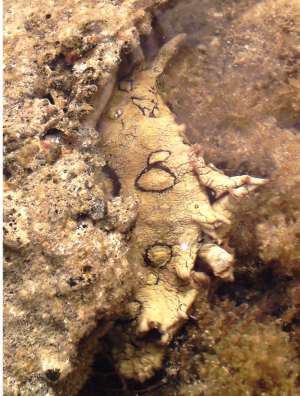
Dear Lucyna,
This is an interesting find. Although this species has been recorded from the western Atlantic and the Canary Ids, I can find only one record of it from the Mediterranean. In Egidio Trainito's recent book he photographed it at Lampedusa Island [between Malta and Tunisia] in 2002. So your find could be the second record of it from the Mediterranean.
There are indeed some beautiful slugs in the cold Baltic. If you look at the links page on the Forum you will see two websites for Norwegian nudibranchs which must be as cold, and also a website for Antarctic animals which is definitely colder
Best wishes,
Bill Rudman
Aplysia dactylomela from Florida
May 7, 2005
From: Erik Sanders

Here are a couple of pics of Aplysia dactylomela I took in August of 2004 in Long Boat Key, Florida. Great color on these specimens.
Locality: Longboat Key, Florida. Gulf Of Mexico. Depth: strandline. Length: approx. 8 inches. early August.Photographer: Erik Sanders
Erik Sanders
eas@stowers-institute.org
Sanders, E., 2005 (May 7) Aplysia dactylomela from Florida. [Message in] Sea Slug Forum. Australian Museum, Sydney. Available from http://www.seaslugforum.net/find/13722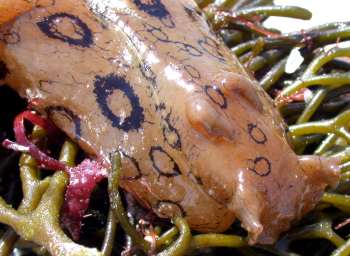
Thanks Erik,
Is nice to get a sea hare other than A. morio and A brasiliana from Florida.
Best wishes,
Bill Rudman
Sea Hares in Tenerife, Canary Ids
April 15, 2005
From: Steve Andrews

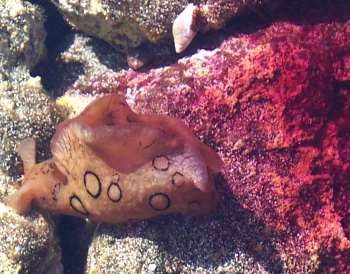
Dear Bill
I have found many specimens of what I feel pretty certain are Aplysia dactylomela in the tidal pools on the beaches between Los Cristianios and Las Americas and also on the main beach at Las Galletas in Tenerife where I live. Yesterday I discovered a Sea Hare which was mainly a dark chocolate brown colour although it looked as if it was the same species as the others and was in the company of more of the A. dactylomela type. I am wondering if a dark brown variation is what this is and how frequently they are found?
Here is a photo of the normal type I find here and this one is sending out a cloud of ink.
Locality: Las Galletas, Tenerife, Canary Islands, Spain. Depth: 10 inches. Length: 8-10 inches. 26 March 2005. Intertidal rockpools. Photographer: Steve Andrews
Steve Andrews
bardofely@gmail.com
Andrews, Steve, 2005 (Apr 15) Sea Hares in Tenerife, Canary Ids. [Message in] Sea Slug Forum. Australian Museum, Sydney. Available from http://www.seaslugforum.net/find/13445Dear Steve,
The animal in the photo is indeed Aplysia dactylomela, which has a circumglobal distribution. I am afraid most species of Aplysia are difficult to identify from a good photo, si I wouldn't attempt to identify a 'dark chocolate brown' one without a photo. All I can say is that, unless there were black rings, it is unlikely to be A. dactylomela, even if it was found with them.
Best wishes,
Bill Rudman
Aplysia dactylomela from St. Martin, West Indies
March 18, 2005
From: Danny Dawson
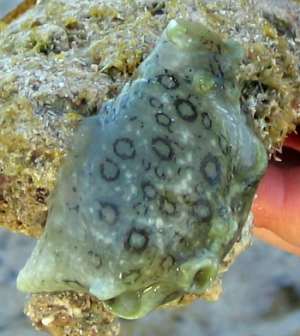
I found this Sea Slug in an intertidal region on the East Coast of St. Martin. It was really beautiful, but I wouldn't touch it for fear it might be poisonous. I think I've identified it from the Forum as Aplysia dactylomela:
www.flickr.com/photos/quasistoic/6509886/
www.flickr.com/photos/quasistoic/6509914/
Locality: Galleon Pond, St. Martin, FWI, Caribbean. Depth: 3-5 inches.
Length: about 3.5 inches. 8 March 2005. Intertidal, fist-sized rocks, a little mucky/slimy. Photographer: Danny Dawson
Danny
seaslug@quasistoic.org
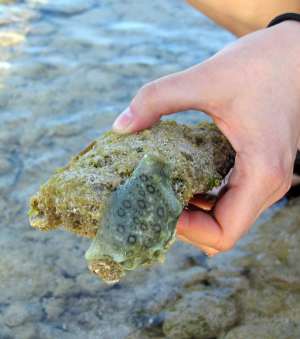
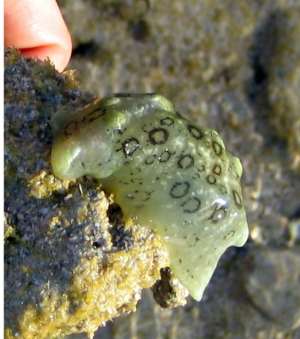
Dear Danny,
Yes this is Aplysia dactylomela. I am quite interested in seeing this greenish animal with quite small black rings. In most of the photos I have seen of Caibbean animals, they are white with large black rings. It would be an interesting little experiment to see if the white animals were associated with areas where the background was white coral sand and the green animals were in areas with a darker, greener background. A good little exercise for a student field trip.
Best wishes,
Bill Rudman
Sea Hares from Netherlands Antilles
March 17, 2004
From: Bob Murphy
On March 13 I was walking along Kim Sha Beach in Sint Maarten, in the Netherlands Antilles.
Two fat, oblong creatures washed up on the beach. If they had been roun, they would have been the size of a baseball. They were dark khaki (kind of tank-coloured), with dark spots, which were actually little circles. I tossed them back into the ocean. When I did so, one of them emitted lots of very dark purple ink. Can you tell me what they were?
Thanks,
Bob Murphy
murphyalberta@hotmail.com
Murphy, R., 2004 (Mar 17) Sea Hares from Netherlands Antilles. [Message in] Sea Slug Forum. Australian Museum, Sydney. Available from http://www.seaslugforum.net/find/12456Dear Bob,
From the dark purple ink, your animals are Sea Hares, See also the page on their ink. The most likely species is Aplysia dactylomela, although its black rings are usually larger than you describe.
Best wishes
Bill Rudman
Aplysia dactylomela from Canary Ids
March 16, 2004
From: Tom + Jade

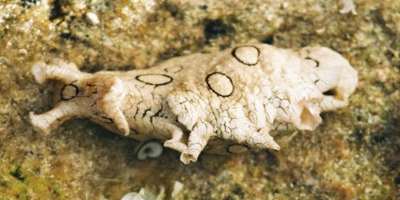
Hi Bill,
My partner and i have just returned from Fuerteventura, [Fuerteventura Island, Canary Ids].
We spotted these beautiful sea-slugs in a rock pool on the north shore of the island, very happy and very much alive. There was also a black one with exactly the same patterning on its body. They were just submerged in adjoining intertidal rock pools, both lying in small run-off channels back into the sea.
I scanned the species list but couldnt find anything resembling them. We are keen to find out what they are and some more about them.
Best Regards,
Tom + Jade
tom@12a.co.uk
Tom + Jade, 2004 (Mar 16) Aplysia dactylomela from Canary Ids. [Message in] Sea Slug Forum. Australian Museum, Sydney. Available from http://www.seaslugforum.net/find/12448Dear Tom + Jade,
This is a Sea Hare and from its pale colour and black rings it can be identified as the Atlantic form of Aplysia dactylomela
Best wishes
Bill Rudman
Aplysia dactylomela and its egg-mass
March 10, 2004
From: Marina Poddubetskaia

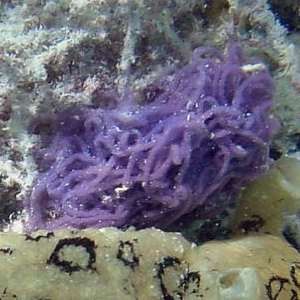
Dear Bill,
I can see many Aplysia dactylomela photos on the Forum, but no any one of its egg-mass. I was expected it to be yellow, but I discovered that it can be violet. It is the only one large Sea-Hare that I've seen in the area. So, I have no doubts these eggs belong to this species.
Date: February 04, 2004
Location: Great Exuma, Bahamas, Western Atlantic
Site: Stocking Island, Sand Dollar Beach
Depth: 1m
Animal's size: 22-23 cm
Photos: Marina Poddubetskaia - Nembro website
Cordially,
Marina.
nembro@nembro.info
Poddubetskaia, M., 2004 (Mar 10) Aplysia dactylomela and its egg-mass. [Message in] Sea Slug Forum. Australian Museum, Sydney. Available from http://www.seaslugforum.net/find/12375Thanks Marina,
I must say I have never seen a purple egg ribbon before. It certainly looks like an aplysiid egg mass. It would be interesting to hear from others on this subject
Best wishes
Bill Rudman
Aplysia dactylomela from the Bahamas
March 1, 2004
From: David Behr
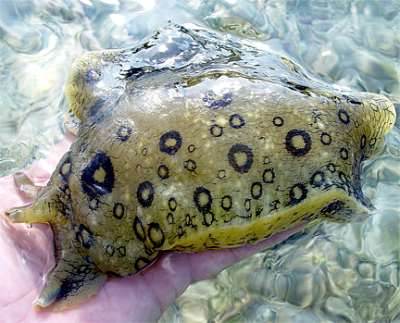
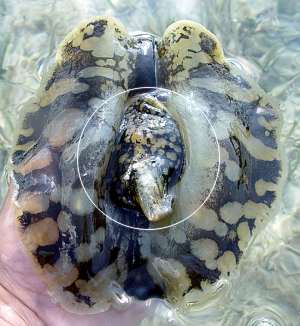
I photographed this species on Feb 21, It was in shallow water on the flats off the Bahama Island of Abaco. I probably shouldn't have picked it up right? - I was gentle and took the pictures located here:
Can somebody help me identify this?
David Behr
metal_gearman@yahoo.com.
Behr, D., 2004 (Mar 1) Aplysia dactylomela from the Bahamas. [Message in] Sea Slug Forum. Australian Museum, Sydney. Available from http://www.seaslugforum.net/find/12340Dear David,
I am sure it didn't mind you gently picking it up. This is a type of sea slug which is usually called a Sea Hare. This species, Aplysia dactylomela, is found worldwide and usually has these black rings. Slugs are snails which have lost their shells. The part I have circled in your lower photo is the mantle. Inside it is all that is left of its shell - a thin flattened fragile plate. Have a look at the Sea Hare shell Page for some photos
Best wishes
Bill Rudman
Aplysia dactylomela from Western Australia
February 11, 2004
From: Monika Stambergova
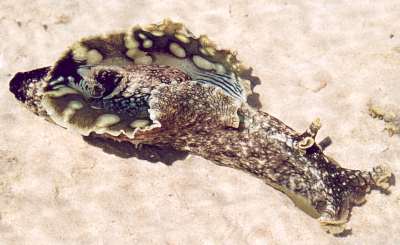
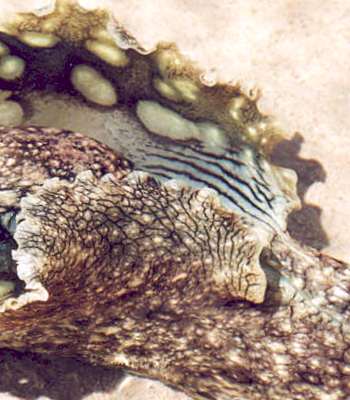
Dear Dr. Rudman,
I wish to ask you about some species I and my friend found in Western Australia last year. Is this one a species of Aplysia?
7 September 2003, Cape Range Nat.Park - Ningaloo Marine Park, Mandu South, rocky sea-coast, found in water pools at low-tide. The animal was about 25 cm long and it produced purple ink after we tried to take animal in our hands.
Well, I was very happy I could visit such a lovely country under the southern cross.
Thank you for your help in advance and sincere congratulations for your wonderful forum!
With best wishes
Monika Stambergova
Czech Republic
stambergova@nature.cz
Stambergova, M., 2004 (Feb 11) Aplysia dactylomela from Western Australia. [Message in] Sea Slug Forum. Australian Museum, Sydney. Available from http://www.seaslugforum.net/find/12172Dear Monika,
I'm glad you enjoyed your visit 'down under'. Yes this is an Aplysia. It is the widespread Aplysia dactylomela. Although the large black rings, usually characteristic of this species,are very small, the large white spots and greeny black colour on the inside of the parapodia are very typical of thsi species
Best wishes
Bill Rudman
Feeding of Aplysia dactylomela
January 26, 2004
From: Albert Diaz Garcia
Dear Bill:
I have some Aplysia dactylomela collected in the Canary Islands. I have them in my tank and i would like to know what kind of algae do they feed and if its possible to feed them with some comercial preparation or and other kind of food different to the algae they eat in the sea.
How long can live these animals?
Thanks for your answer and congratoulations for your page.
Is there any company or institution that comercialice Aplysias for the laboratories?
Albert Diaz Garcia
albertodiaz@cpd.es
Garcia, A.B., 2004 (Jan 26) Feeding of Aplysia dactylomela. [Message in] Sea Slug Forum. Australian Museum, Sydney. Available from http://www.seaslugforum.net/find/11941Dear Albert,
Have a look at my answer to Patricia Chen's message. A. dactylomela seems to be a fairly specialised red algal feeder, Rogers et al (2002) finding it would only eat Laurencia obtusa, but possibly when its favourite food is absent it will eat other algae. Here are a few references specifically about A. dactylomela.
• Carefoot,T.H. (1982) Phagostimulatory properties of various chemical compounds to sea hares (Aplysia kurodai and A. dactylomela). Marine Biology, 68: 207-215.
• Carefoot,T.H. (1991) Blood-glucose levels in the sea hare Aplysia dactylomela: interrelationships of activity, diet choice and food quality. J. Exp. Mar. Biol. Ecol., 154: 231-244.
• Rogers, C.N., De Nys, R., Charlton, T.S. & Steinberg, P.D. (2000) Dynamics of algal secondary metabolites in two species of Sea Hare. J. Chem. Ecol., 26(3): 721-744.
For more general references in Aplysia feeding, there is a page on the Forum listing feeding references. However it may be worth experimenting on something easy to collect like the 'sea lettuce' Ulva which is less likely to foul aquarium water with secretions than browns and reds are. I am not sure whether A. dactylomela would find Ulva attractive or not. Concerning how long they live. I suspect they live less than a year, but it is possible a few last for a second year.
Concerning commercial operations, see my message about the NIH-Aplysia Resource Facility in Miami, Florida. I think it is the only one.
Best wishes,
Bill Rudman
Aplysia dactylomela from Dominica
January 6, 2004
From: Valérie Grando
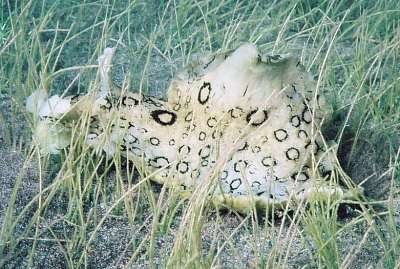
Hi,
I have photographed a seaslug that most resembles Aplysia dactylomela, but I am still not sure if it is this one. The picture was taken in about 1 meter depth in Dominica in March 2003
Valérie
vgrando@nordnet.fr
Grando, V,, 2004 (Jan 6) Aplysia dactylomela from Dominica. [Message in] Sea Slug Forum. Australian Museum, Sydney. Available from http://www.seaslugforum.net/find/11750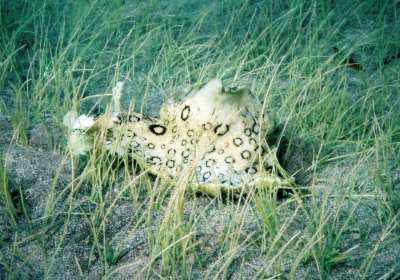
Thanks Valérie,
Yes this is Aplysia dactylomela. This species is found in warm waters all around the world. Your photo is rtaher typical of Caribbean animals with its particularly white background colour and very defined black rings
Best wishes
Bill Rudman
Aplysia dactylomela(?) from Brazil
November 18, 2003
From: Vinicius Anderson
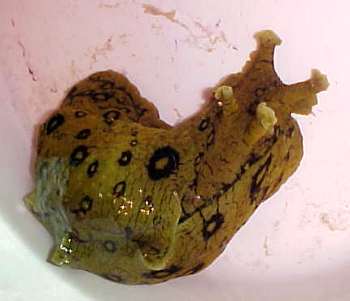
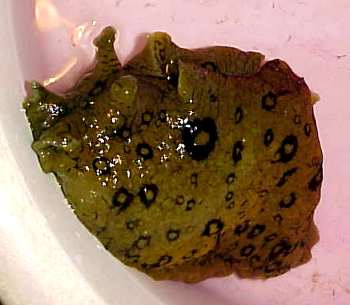
Hi Bill,
I send to the forum these photos of an Aplysia. This specimen was collected for me and my friend Cléo Dilnei at night. I think there is an Aplysia dactylomela. I´m not sure because the black rings are formed from a single but thick ring. There is similar to John Dohmen´s photo but I can´t see two rings in this animal.
Date: October 22 2003
Location: Conchas Beach, Cabo Frio, Rio de Janeiro - Brasil
Depht: 3 meters
Size: ~20cm
Have a nice trip!
Best wishes,
Vinicius Anderson
viniciusanderson@hotmail.com
Anderson, V., 2003 (Nov 18) Aplysia dactylomela(?) from Brazil. [Message in] Sea Slug Forum. Australian Museum, Sydney. Available from http://www.seaslugforum.net/find/11326Dear Vinicius,
This is indeed Aplysia dactylomela. If you look at some of the other photos on the Forum this species can have thick rings and often when they have thick rings, the rings appear to be a double ring. Usually though the rings are quite thin. From the tinge of red in the water it looks like your animal produced some ink.
Best wishes
Bill Rudman
Aplysia dactylomela from Jamaica
October 6, 2003
From: Ross W. Gundersen
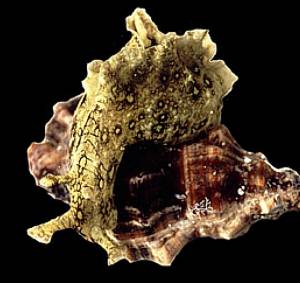
Dear Bill:
I promised to send you pictures of Caribbean slugs quite a while ago, and here is the first of a series of messages. I have taken IDs as far as I can with my limited knowledge and would welcome any corrections. All specimens were collected from St. Ann's Bay, Jamaica, West Indies. Most specimens were collected using a light weight dredge and photographed by R. Gundersen.
Here is Aplysia dactylomela. On rocks in Thallasia bed
Best wishes,
Ross W. Gundersen
University of Wisconsin
ross.gundersen@uwp.edu
Gundersen, R.W., 2003 (Oct 6) Aplysia dactylomela from Jamaica. [Message in] Sea Slug Forum. Australian Museum, Sydney. Available from http://www.seaslugforum.net/find/11097Thanks Ross,
Your photos will be a valuable addition to the Forum
Best wishes
Bill Rudman
Re: Aplysia dactylomela from the Canary Ids
July 2, 2003
From: Ron Warne
Concerning Sjoerd's message about Aplysia dactylomela in the Canary Ids - I was in Tenerife (8 June 2003) and saw about 10 sea hares with the pale colouration very close to the shore in the rocky beached lagoon next to the Playa del Durque beach in Costa Adeje. Depth about 1 to 3 meters. I didnt even need to leave the surface to reach to some of them - I was absolutely fascinated with them and the brilliant fish that were also abundant. It was definitely one of the highlights of my holiday.
Great website.
Ron Warne
ron.warne@ntlworld.com
Thanks Ron,
Bill Rudman
Aplysia dactylomela from Senegal
June 24, 2003
From: Marina Poddubetskaia
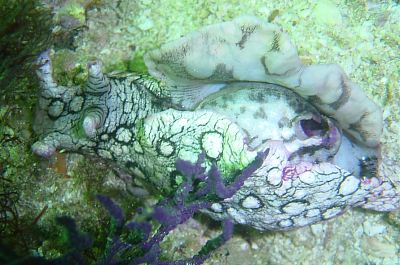
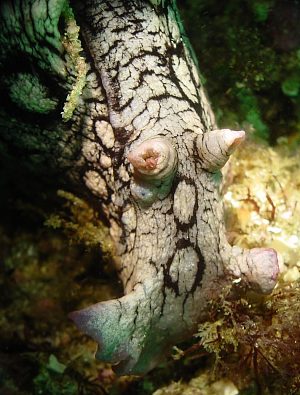
Dear Bill,
Here is Aplysia dactylomela from Dakar, Senegal. This species is very common there, especially in shallow waters. This photo was taken just after the animal was inking (purple ink).
Date: May 29, 2003
Location: Dakar, Senegal, Eastern Atlantic
Site: Cap Manuel
Depth: 8m
Size: 15-16cm
Photos: Marina Poddubetskaia - Nembro website
Best wishes,
Marina.
nembro@nembro.info
Poddubetskaia, M., 2003 (Jun 24) Aplysia dactylomela from Senegal. [Message in] Sea Slug Forum. Australian Museum, Sydney. Available from http://www.seaslugforum.net/find/10259Thanks Marina,
Bill Rudman
Aplysia dactylomela from the Canary Ids
June 13, 2003
From: Sjoerd Westerterp
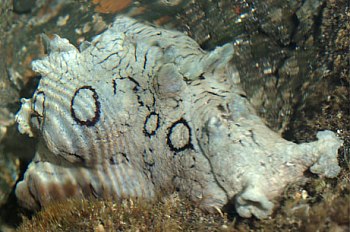
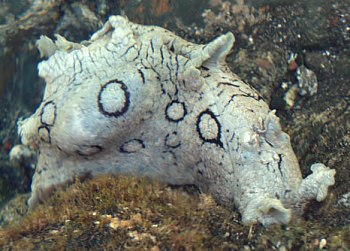
Hi,
I have photographed a seaslug that most resembles the Aplysia dactylomela, but I am still not sure it is exactly the same species. Maybe you can have a look and tell me what you think. I found this one in a small seccluded bay on the island La Gomera (Canary Islands) during low tide. I saw only one, and only once.
Cheers!
Sjoerd Westerterp
x22048@westerterp.com
Westerterp, S., 2003 (Jun 13) Aplysia dactylomela from the Canary Ids. [Message in] Sea Slug Forum. Australian Museum, Sydney. Available from http://www.seaslugforum.net/find/9979Dear Sjoerd,
Yes this is Aplysia dactylomela. Specimens from the Caribbean [see Anne DuPont's photos] are often this very pale colour as well
Best wishes,
Bill Rudman
Information on Aplysia diet
February 6, 2003
From: Ana Karina Yepes
Hello
I am an undergraduate student of Biology of The University of Antioquia in Medellin, Colombia. I'm making my degree work in the Chemical Defence of Aplysia dactylomela and Discodoris evelinae, the first is vegetarian and the second is spongivorous. One of my objectives in this research is analyze the stomach content of this two species, and knowing that this is in the Caribbean, I would like to know if any one has information about the species of macroalgae that the Aplysia eat, but even if it is not from the Caribbean I would like information or bibliography on the Aplysia diet.
Greetings,
Ana Karina Yepes
akyepes@hotmail.com
Have a look at my answer to Patricia Chen's message. A. dactylomela seems to be a fairly specialised red algal feeder, Rogers et al (2002) finding it would only eat Laurencia obtusa. Here are a few references specifically about A. dactylomela.
• Carefoot,T.H. (1982) Phagostimulatory properties of various chemical compounds to sea hares (Aplysia kurodai and A. dactylomela). Marine Biology, 68: 207-215.
• Carefoot,T.H. (1991) Blood-glucose levels in the sea hare Aplysia dactylomela: interrelationships of activity, diet choice and food quality. J. Exp. Mar. Biol. Ecol., 154: 231-244.
• Rogers, C.N., De Nys, R., Charlton, T.S. & Steinberg, P.D. (2000) Dynamics of algal secondary metabolites in two species of Sea Hare. J. Chem. Ecol., 26(3): 721-744.
For more general references in Aplysia feeding, there is a page on the Forum listing feeding references. However the only way to be sure just what your population is feeding on is to observe them in the field and perhaps do some simple choice experiments in the lab.
Best wishes,
Bill Rudman
Aplysia dactylomela from Lord Howe Island
January 18, 2003
From: W.B. Rudman
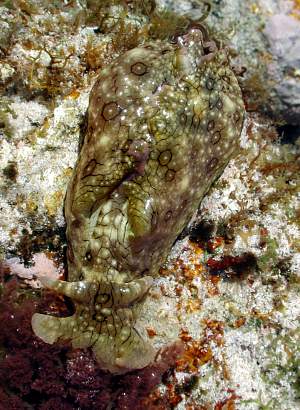
Here is a photo record from Ian Hutton of Aplysia dactylomela from Lord Howe Island.
Location: Neds Beach.
Bill Rudman
Rudman, W.B., 2003 (Jan 18) Aplysia dactylomela from Lord Howe Island. [Message in] Sea Slug Forum. Australian Museum, Sydney. Available from http://www.seaslugforum.net/find/8818Aplysia dactylomela from Equatorial Guinea
October 14, 2002
From: Felix Villares
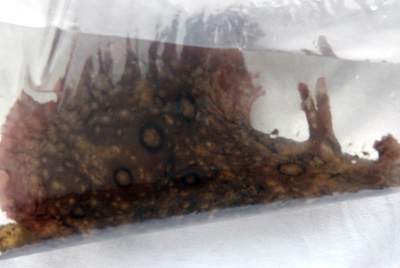
Dear Bill,
I found Aplysia dactylomela during the last year diving near Bata and other localities in Rio Muni region (Equatorial Guinea). It was very common in December. I am sorry the photo is not good.
Felix Villares
elbuzo@guay.com
Villares, F., 2002 (Oct 14) Aplysia dactylomela from Equatorial Guinea. [Message in] Sea Slug Forum. Australian Museum, Sydney. Available from http://www.seaslugforum.net/find/8154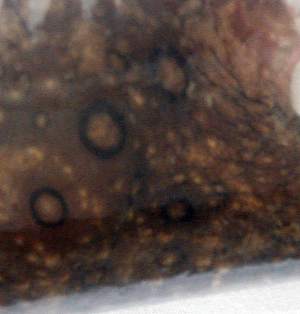
Dear Felix,
Thanks for the information. The west coast of Africa is one part of the world of which we know very little of the opisthobranch fauna. Any information therefore is very welcome. The black rings on Aplysia dactylomela make it particularly easy to identify.
Best wishes,
Bill Rudman
'Mango Seeds' = Aplysia dactylomela
June 13, 2002
From: Dr. Ray McAllister
Dear Bill,
Thanks for your reply to my message. The 'mango seeds' all over the bottom were Aplysia dactylomela. I had never seen one in Florida before and a week later saw none when I returned to check. I think an assemblage this big had to be a mating thing although I saw no mating chains such as you showed in the Forum.
Spanish dancers appear in our brackish water canals every so often. Perhapd 50 in sight at a time. Purplish color. Anne DuPoint will be called next time it happens and try to get photos and observe the situation. It has happened several times according to my respondent.
Dr. Ray McAllister
dinodivr@bellsouth.net
McAllister, R., 2002 (Jun 13) 'Mango Seeds' = Aplysia dactylomela. [Message in] Sea Slug Forum. Australian Museum, Sydney. Available from http://www.seaslugforum.net/find/7237Thanks Ray,
I will be very interested to hear about or see a photo of the Spanish Dancers.
Cheers,
Bill Rudman
Spanish Dancer congregation in Florida
June 7, 2002
From: Dr. Ray McAllister
About once a year a congregation of Spanish Dancers occurs in canals in Pompano Beach Florida. We see dozens at this time and at low tide go out to release the ones caught on sloping seawalls, docks and boat lifts. If someone is interested, contact me and I will notify them next time it happens.
As an aside, 20 years ago the sea floor in 20 feet of water was covered with many hundreds of "mango seeds". After wondering who ate all these mangos, I dove down and oicked one up. They were a biocenosis of gray green nudibranchs by the hundreds. I have never before or since seen this particular nudibranch in Florida waters (or anywhere else). The following Saturday I went back to the spot and could find not a single nudibranch, living or dead! This species (for non-mango eaters, is about 5 or 6 inches long and 3/4 of an inch thick, just like the seeds.
Dr. Ray McAllister, Prof. Emeritus, Ocean Engineering
dinodivr@bellsouth.net
McAllister, R., 2002 (Jun 7) Spanish Dancer congregation in Florida. [Message in] Sea Slug Forum. Australian Museum, Sydney. Available from http://www.seaslugforum.net/find/7150Dear Ray,
Thanks for these observations. Some photos would be very welcome. I assume by 'Spanish Dancer' you are talking about the colourful nudibranch Hexabranchus morsomus. I don't have a photo of it on the Forum but it looks quite similar to the common Indo-West Pacific species Hexabranchus sanguineus. If your animal was a Hexabranchus then your observations are quite interesting because I did not know either species 'swarmed'. Common names can be a problem because sometimes "Spanish Dancer" is used for any swimming Sea Slug, which raises the possibility that you are talking about a Sea Hare. There are two species Aplysia brasiliana and Aplysia moriowhich are commonly reported to 'swarm' in Florida.
Concerning your 'mango seeds'. Its possible you are describing another sort of Sea Hare, Bursatella leachii, which is about the right size, can be found swarming in Florida, lives on soft muddy sand, and can't swim.
Look forward to your reply,
Best wishes,
Bill Rudman
Aplysia dactylomela feeding
June 3, 2002
From: Anne DuPont
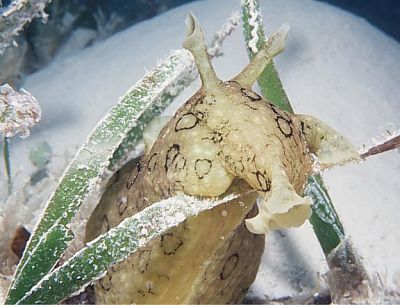
Bill,
Here is A. dactylomela feeding. They were "slurping or sucking" the growth (hydroids/algae(?)) from the eel grass blades. Photo taken in Exuma, Bahamas, December, 2001 in about 10 feet of water. This specimen was about 5 inches long.
Thank you.
Anne DuPont
akdupont@bellsouth.net
DuPont, A., 2002 (Jun 3) Aplysia dactylomela feeding. [Message in] Sea Slug Forum. Australian Museum, Sydney. Available from http://www.seaslugforum.net/find/7104Thanks Anne,
It certainly looks like they are short of food. Normally large Sea Hares are macro-algal feeders, so they must be hungry to be 'slurping' along the sea grass blades, as you describe, feeding. I guess, either on a film of unicellular algae or algal sporelings.
Best wishes,
Bill Rudman
Aplysia dactylomela in the Bahamas
May 27, 2002
From: Anne DuPont
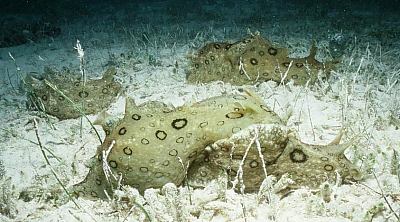
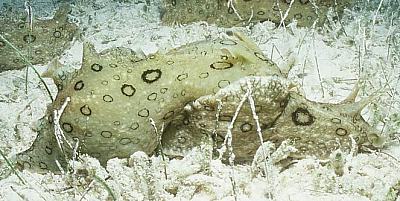
Hi Bill,
Here are some photos of A. dactylomela I took in the southern Bahamas on January 3, 2002.
We were anchored on our boat in the same location in the Southern Bahamas for 3 months. I was able to photograph and observe A. dactylomela over this period. Over the 3 months I probably saw about 70 of them. I found them: feeding, sleeping (I think), mating, and in sizes from 1 inch to about 8 inches. All of them were various shades of green except one dark brown one. They were in 3 feet to about 12 feet of water crawling in the sand in eel grass and along an algae covered wall.
Thank you for your time and for the wonderful forum.
Cordially,
Anne
akdupont@bellsouth.net
DuPont, A., 2002 (May 27) Aplysia dactylomela in the Bahamas. [Message in] Sea Slug Forum. Australian Museum, Sydney. Available from http://www.seaslugforum.net/find/7060Dear Anne,
Thanks for your photos - they are always welcome. The Forum is only as wonderful as the wonderful contributions I receive. I have posted your photos of Aplysia mating chains as a separate message and broken my rules by publishing them at full width. Just as well there were not 5 or 6 to photograph!
Thanks again,
Bill Rudman
Colour variation in Aplysia dactylomela
April 21, 2002
From: Anne DuPont
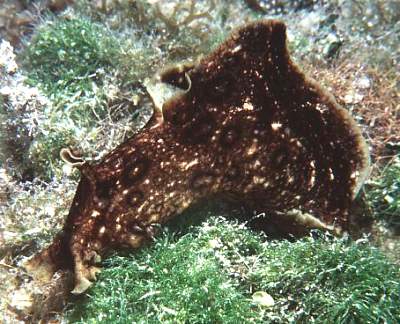
Hi Bill,
I have just returned from the southern Bahamas where I have been photographing lots of Aplysia dactylomela. I found them feeding, sleeping, and in mating chains (photos to come). Most of the animals I found were lime green with the dark black rings, but one day I found a very dark brown one, it looked like Aplysia brasiliana but it has rings. I am sending pairs of photos, one lightened up so you can see the.
I sent the photos to Dr Tom Carefoot who replied that he had found A. dactylomela of all shades and colours in Jamaica, from greyish-green to almost chocolate brown, but that the rings are always a dead give-away.
Best regards,
Anne DuPont
Delray Beach, Fl
akdupont@bellsouth.net
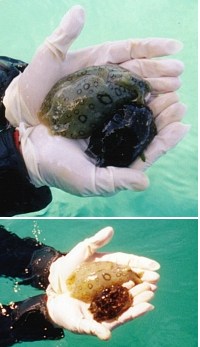
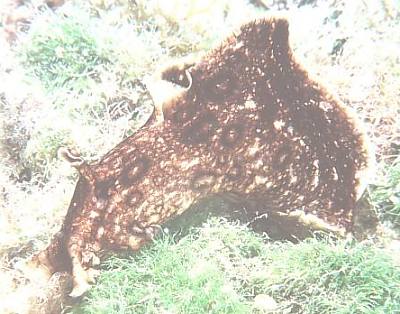
Dear Anne,
Thanks for the photos. A. dactylomela certainly shows a range of colour in the Indo-West Pacific although I haven't seen one quite as dark brown as in your photo. I certainly look forward to few photos of your Bahamas animals in mating chains etc
Best wishes,
Bill Rudman
Sea Hare from Puerto Rico
April 15, 2002
From: Natalie Manno
I first came in contact with this bold colored creature when I was walking along the shore of a small island in Puerto Rico about 3 years ago. I am very interested in marine life, so I poked at it with a small piece of coral to see if it was aggressive. After nothing happened I scooped it up in my hand and slowly lifted it out of the water to get a better look. I had never seen anything like it before, so I took a few pictures, and then put it back in the sea weed bed where I found it. I showed some friends who scuba dive and nobody seemed to know what it was. I'm now a biology student in college and came across sea slugs while studying molluscs, which led me to this website which I think is very informative. I now know I had found a sea hare, light green with dark green circles [Aplysia dactylomela]. My question is this; are they in anyway harmful to humans? Should I have picked up the one I found? Did I hurt it by picking it up?
Sincerely,
Natalie Manno
North Tonawanda, NY
gitana0709@aol.com
Manno, N., 2002 (Apr 15) Sea Hare from Puerto Rico. [Message in] Sea Slug Forum. Australian Museum, Sydney. Available from http://www.seaslugforum.net/find/6731Dear Natalie,
In the normal course of events Sea Hares are not dangerous to humans. If you have a look at the Sea Hares page you will find links to a lot more information on this fascinating group of sea slugs. Be sure to look at the messages at the bottom of each page as they often contain a lot of interesting observations and comments. Lifting them out of the water for a look is also unlikely to damage them as long as you don't let them dry out.
I guess you weren't thinking of eating them as that can be a bit risky. Have a look at Peter Taylor's message and the subsequent discussion concerning dogs eating Sea Hares in Western Australia.
best wishes,
Bill Rudman
Seahares in New Zealand
March 6, 2002
From: Leanne Ticehurst
Hi there,
I am a new diver to New Zealand waters, I have to say it's more than I was giving it credit for. Anyway, I was diving off the south coast of Wellington, NZ in Island Bay and came across my first Sea Hare in any of my diving. The one I saw was about a foot in length and the body black with a flowing mane of black/greyish stripes running horizontally down the back, the thing that really got me though was after looking at it for at least 4-7 minutes it started to eject a pink/lilac fluid, initially I thought it was an octopus but further examination showed it wasn't. It wasn't provoked at all only 2 divers about 5 inches away from it trying to work out what we were seeing, and it was attached to a rock by it's black part.
I am hoping that you may be able to provide me with some more information about this incredible creature as I am keen to keep an eye out for more of them, this was the only one I saw from both my dives here.
Thanks heaps,
Leanne Ticehurst
Wellington,
New Zealand.
ljt_rowfreak@hotmail.com
Ticehurst, L., 2002 (Mar 6) Seahares in New Zealand. [Message in] Sea Slug Forum. Australian Museum, Sydney. Available from http://www.seaslugforum.net/find/6354Dear Leanne,
Your animal was obviously a Sea Hare. If you look at the Sea Hares page you will find links to other pages with information on these fascinating animals.
Unless you can send me a photo it is a bit difficult to be sure which species you have seen. However from your estimate of its length I would suspect it was probably Aplysia dactylomela, which is the only species reported to grow that large in New Zealand.
Best wishes,
Bill Rudman
Aplysia dactylomela from the Canary Ids
December 5, 2001
From: Simon and Jill Warwick
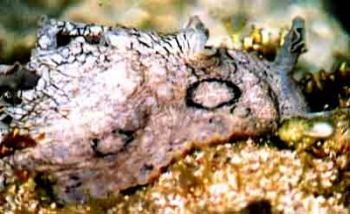
During a visit to the Canary Ids we found at least four of the above sea hares located in rock pools on the island of Fuerteventura (on the rocky shore west of the village of El Cotillo in the North-west of the island) on 16 April 2001. Photographs taken and ID confirmed from this website last night!
Rock pools varied in depth (two feet at most) but the sea hares were in the shallower sections much closer to the surface. This photo was taken from above the surface so the picture is far from perfect but hopefully good enough to ID. We assume they are reasonably widely distributed throughout the Canaries?
Many congratulations on the Sea Slug Forum, it has inspired us to look more closely in the future!
Best wishes
Simon and Jill Warwick
simon@swland.co.uk
Warwick, S. & J., 2001 (Dec 5) Aplysia dactylomela from the Canary Ids. [Message in] Sea Slug Forum. Australian Museum, Sydney. Available from http://www.seaslugforum.net/find/5768Dear Simn & Jill,
Thanks for the record. A. dactyomela is known from the tropical and warm temperate parts of the Indo-West Pacific and the west Atlantic [Caribbean to Brazil]. In the eastern Atlantic it is known from the Canary Islands, Cape Verde Islands and Ghana but apparently not from the Mediterranean or the European mainland (Cervera et al, 1988).
As you will see in the Forum, the Atlantic form appears to have a much paler, nearly white, background colour than in the Indo-West Pacific form. In fact an animal from the Canary Ids, very similar in colour to the one in your photo, was described as a distinct species, Aplysia ocellata, by D'Orbigny in 1839. However it is generally thought the the Atlantic and Indo-Pacific animals should be considered a single species.
• Cervera, J.L., Templado, J., Garcia-G¢mez, J.C., Ballesteros, M., Ortea, J.C., Garcia, F.J., Ros, J. & Luque, A.A. (1988) Catalogo actualizado y comentado de los opistobranquios (Mollusca, Gastropoda) de la Peninsula Iberica, Baleares y Canarias, con algunas referencias a Ceuta y la Isla de Alboran. (Annotated and updated Checklist of Opisthobranchs (Mollusca, Gastropoda) from Iberian Peninsula, Balearic and Canary Islands, with some references to Ceuta and Alboran Island). Iberus (Suppl. 1): 83pp.
• d'Orbigny, A. (1839) Mollusques, echinodermes, foraminiferes et polypiers, recueillis aux Iles Canaries. [In] Webb, P.B., & Berthelot, S., 1835-50. Historie naturelle des Iles Canaries, Paris, 2 (2) Zoologie, 37-45.
Best wishes,
Bill Rudman
Feeding preference of Aplysia dactylomela
October 26, 2001
From: Patricia Chen
Hi Bill.
I am an undergraduate student from the University of California, Los Angeles. I am currently participating in a marine biology program at the Hawaii Institute of Marine Biology in Kaneohe Bay, Hawaii.
I am interested in doing a research project on the feeding preferences of the spotted sea hare, Aplysia dactylomela. While on scuba and snorkel around Kaneohe Bay I have discovered large numbers of A. dactylomela living on the red algae Acanthophora specifera and have become fascinated by them. However, I've been doing some research on this creature and have come across some conflicting information. Some sources say it eats only red algae while others list it as eating the green algae Caulerpa and Halimeda. I've also heard that in captivity, it prefers greens over reds. I was wondering if you could clear this up for me.
Also I was wondering if you could give me an estimate of how fast they move. I'm planning on putting each individual sea hare in a tank with 4 choices of algae so I need to choose an appropriate tank size. I've been looking in various sources and haven't found too much info on this particular sea hare. Is there any book or journal you recommend?
Thanks for all your help, I really appreciate it.
Sincerely,
Patricia Chen
pschen@ucla.edu
Chen, P., 2001 (Oct 26) Feeding preference of Aplysia dactylomela. [Message in] Sea Slug Forum. Australian Museum, Sydney. Available from http://www.seaslugforum.net/find/5517Dear Patricia,
Have a look at the general Sea Hares Page for links to more specific information. There is a page with referemces to scientific research on Sea Hare feeding but I am not sure if Aplysia dactyomela is one of the species that has been researched.
As a general rule it seems that sea hares can change their diet but seem to settle on red algae, different species preferring different species of red. Some species do move inshore and can live on green algae, such as Ulva, but I can't recall hearing of them feeding on Caulerpa and Halimeda so would be interested in a reference to your information.
How fast they move? I guess someone may have timed them, but I would think their size would be a more important thng to consider when deciding on what tank size to use. These sort of things are best done by trial and error. I presume you can try things out before deciding on your final experimental design. Scince may look neat and tidy when its published, but behind most neat and tidy "Methods" and "Results" sections is an incredible tangle of mistakes, errors and accidents.
Good Luck with your work. Hopefully someone can point us towards some published work on the diet of A. dactylomela
Best wishes,
Bill Rudman
Black Sea Hare and mystery from Curacao
June 20, 2001
From: John Dohmen

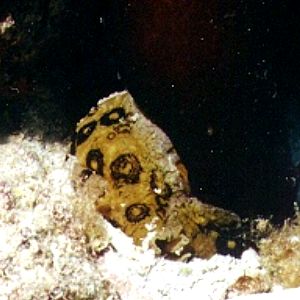
While diving in Curacao, Netherlands Antilles, [Caribbean] I found these slugs in the bay not far from shore. As far as I can determine these are Black Sea Hares. The largest was about 12 inches long.
But my question is: What is the light brown "thing"? It looked attached to one of the black sea hares, but it didn't look like mating sea hares. It looked more like a part of the Black Sea Hare. If I had found the brown one apart I would have concluded it is a Spotted Sea Hare, but I don't think both species would be together at this spot. I dive on a very regular basis here and during all the years I have never seen these giant slugs. So I think they are rather uncommon here. And then to find two different slugs of the same family seems unlikely.
Do you have any idea?
Greetings,
John Dohmen
dohmen@curacao-diving.com
Dohmen, J., 2001 (Jun 20) Black Sea Hare and mystery from Curacao. [Message in] Sea Slug Forum. Australian Museum, Sydney. Available from http://www.seaslugforum.net/find/4630Dear John,
There is only one law of nature - expect the unexpected! The big black Sea Hares are almost certainly Aplysia morio and the little brown mystery is Aplysia dactylomela which I see Humann calls the "Spotted Sea Hare". Your animal has very thick black rings. These appear to be the result of the merging of a pair of concentric rings. As Humann's book illustrates, the black rings in Caribbean specimens of Aplysia dactylomela are sometimes formed from a pair of concentric rings rather than a single ring as in the Indo-West Pacific.
Why are both species together? I guess most species of Aplysia have similar ecological requirements, so it is not uncommon to find mixed clusters of Sea Hares, often of two species, sometimes of more.
Best wishes,
Bill Rudman
Re: Sea Hare from Thailand
May 10, 2001
From: Kathe R. Jensen
Dear Bill & Wallabha,
There are previous, published records of sea hares from Thailand, but Aplysia dactylomela is not one of them apparently. In 1902 Rudolph Bergh described 4 species from the region around Koh Chang and Koh Kahdat (which I think is rather close to Koh Samet). The preserved specimens are still intact in the Zoological Museum in Copenhagen, Denmark. Three of these species he described as new to science, but in present-day taxonomy they have been identified as: (1) Aplysia euchlora (Adams in Gray, 1850),(2) and (3) Petalifera petalifera (Rang, 1828) and (4) Bursatella leachi Blainville, 1817 (see Jensen, 1998). The last species is definitely very common. I have been asked numerous times if it will eat or harm the shrimps in aquaculture ponds, because they apparently like entering these ponds to spawn, and this is just about the time of year when they spawn.
By the way, the species that I called Stylocheilus longicauda in the above paper, should be S. striata.
References:
• Bergh, R. (1902). Gastropoda Opisthobranchiata. The Danish Expedition to Siam 1899-1900. - Det Kongelige Danske Videnskabernes Selskabs Skrifte, 6. Raekke, naturvidenskabelig og mathematisk Afdeling 12(2): 161-218, plates 1-2, 1 map.
• Jensen, K.R. (1998) Anatomy of some opisthobranch molluscs from Phuket, Thailand with a list of Opisthobranchia recorded from Thai waters. Phuket Marine Biological Center Special Publication ,18(2): 243-262.
Greetings,
Kathe
jensen@ait.ac.th
Jensen, K.R., 2001 (May 10) Re: Sea Hare from Thailand. [Message in] Sea Slug Forum. Australian Museum, Sydney. Available from http://www.seaslugforum.net/find/4301Thanks Kathe,
From some of the earlier messages, it seems Bursatella in shrimp/prawn ponds is a worldwide phenomenon.
Bill Rudman
Sea Hare from Thailand
May 4, 2001
From: Walabha Sinbul
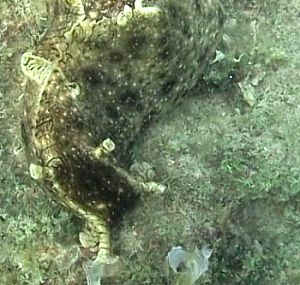
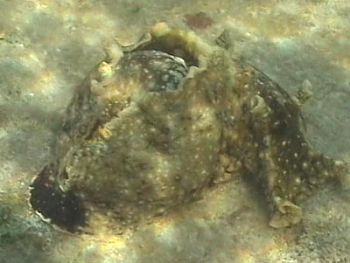
Dear Bill,
I've been diving in Thailand for about 3 years and my interest is always about seaslug and nudibranch.
On April 14, while snorkeling with friends during ours holidays at Samed Island, Thailand, a friend of mine yelled that he found a gigantic snail grazing on green algae on the rock at about waist deep water. After taking a good look at that "gigantic snail", I yelled back to him that this chap was not an ordinary snail. He was a sea hare! Then we started to look around to search for more. We ended up finding about 20 sea hares! Some of them was eating alone. Some of them stayed close together as if ther were couple. The biggest one that we found was about 12 inches long [30cm]. The bigger they were, the darker their color was. We even found their pink ribbon like string of eggs attached to the rock nearby. I told my friend that we have to tell Bill about our discovery!
So Bill, could you please help us identify these sea hares we found? I browsed through the species list and it looks to me that they are Aplysia dactylomela. Thank you very much Bill. And by the way, is this a sea hare first report from Thailand? I have a feeling that they have been overlooked by divers because they are very big and very easy to spot. I don't know for other, but for me, they're so cute!
Sincerely yours
Walabha
walabha@hotmail.com
Sinbul, W., 2001 (May 4) Sea Hare from Thailand. [Message in] Sea Slug Forum. Australian Museum, Sydney. Available from http://www.seaslugforum.net/find/4264Dear Walabha,
Thanks for the photos. Yes this is Aplysia dactylomela, which is one of the common tropical Sea Hares. I don't know of any records of Sea Hares from Thailand but there is no reason why there shouldn't occur there. Sea Hares are often overlooked because they are quite well camouflaged and because they often live in places that are not that good for nudibranchs. But as you have discovered, when they are big and occur in large numbers they are quite difficult to ignore.
Best wishes,
Bill Rudman
Re: Aplysia from South Africa
January 17, 2001
From: Richard Willan
Dear Bill,
I agree that the Sea Hare Valda has recently had up on your site is most probably Aplysia dactylomela. It is certainly a very dark individual; if it werea cowrie one would describe it as melanistic. Although I cannot make out any dark rings on the body, I can see some dark "veins" on the rhinophores that are characteristic of A. dactylomela.
Bob Bolland's photo of Chromodoris vibrata from Okinawa is most exciting.
Another supposed Hawaiian endemic species bites the dust. There is so much still
to discover.
Cheers,
Richard
Richard.Willan@nt.gov.au
Willan, R., 2001 (Jan 17) Re: Aplysia from South Africa. [Message in] Sea Slug Forum. Australian Museum, Sydney. Available from http://www.seaslugforum.net/find/3537Thanks Richard,
Concerning Chromodoris vibrata, Scott Johnson also notes finding juveniles at the Marshall Ids.
Best wishes,
Bill Rudman
More photos of possible Aplysia oculifera
January 14, 2001
From: Valda Fraser
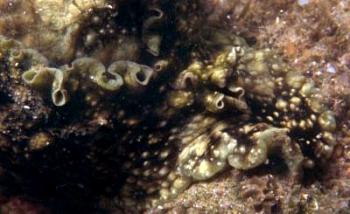
Dear Bill
Here are some more photos of the animal you think might be Aplysia oculifera. Unfortunately the water was not too clean, but I hope you can see enough to confirm your identification.
Regards
Valda Fraser
valdafraser@mweb.co.za
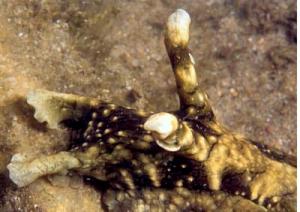
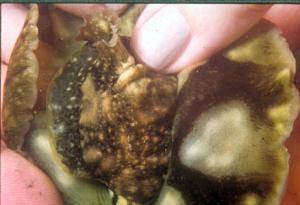
Dear Valda,
Thanks for the extra photos. Although they don't show the whole animal they in fact give me a much better idea of what it looks like. I am pretty sure it is not Aplysia oculifera but a very dark form of Aplysia dactylomela. Although I can't see any sign of the characteristic large black rings, the pattern on the inside of the parapodia (bottom right photo) and the thickened look of the parapodial wall are very characteristic of that species. In Terry Gosliner's book there is a photo of an animal with very small black rings, so apparently in your part of the world the rings can become quite small.
Best wishes,
Bill Rudman.
Aplysia oculifera? from South Africa
January 10, 2001
From: Valda Fraser
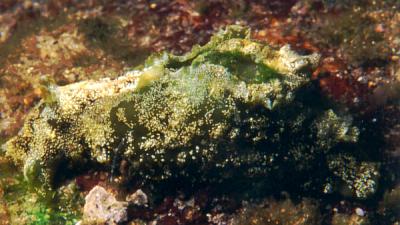
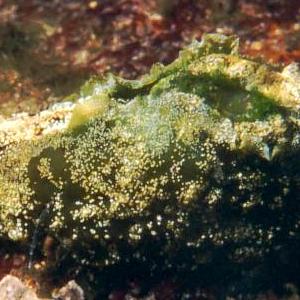
Dear Bill
I wish to confirm that this is Aplysia dactylomela.
Locality: Pumula, south coast KwaZulu-Natal, SOUTH AFRICA - intertidal zone
Date: December 2000
Size: 60mm
Thanks,
Valda
valdafraser@mweb.co.za
Fraser, V., 2001 (Jan 10) Aplysia oculifera? from South Africa. [Message in] Sea Slug Forum. Australian Museum, Sydney. Available from http://www.seaslugforum.net/find/3464Dear Valda,
I know they are a pain to photograph but I will need some clearer photos before I can hazard a guess at this. It is an Aplysia, perhaps Aplysia oculifera, but I can't see any colour details to be sure. This animal seems to have quite short parapodia, not extending far above the shell, and they see, quite thin, which is unlike A. dactylomela. A. dactylomela also has distinctive black rings on the parapodia and I can see no sign of then in your photo. In Aplysia oculifera there are dark brown or black rings but they are very small. Even a close-up photo of part of the mantle so I can see any colour pattern might be a help.
Best wishes,
Bill Rudman
Aplysia dactylomela swimming
December 11, 1999
From: Anne Dupont

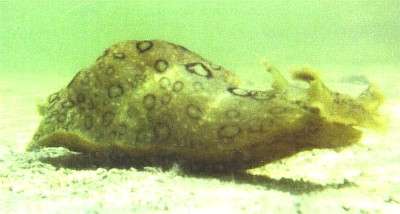
Hi Bill,
Here are a couple of better photos of A. dactylomela to maybe replace the terrible ones I sent you earlier.
Closeup photo taken off Spanish Wells Island, Bahamas.
Swimming photo taken Key West, Florida Keys, Florida
Happy Holidays, and I hope you get some time off!
Cordially,
Anne
adupont@gate.net
Dupont, A., 1999 (Dec 11) Aplysia dactylomela swimming. [Message in] Sea Slug Forum. Australian Museum, Sydney. Available from http://www.seaslugforum.net/find/1670Dear Anne,
Thanks for the photos. I never thought of A. dactylomela as a swimmer. Most swimming Sea Hares flap their large parapodia, a bit like the wings of a bird (See A. extraordinaria). However from the photo, would I be right in thinking that A. dactylomela swims by flexing its whole body?
Concerning your earlier photos. They are great! Field shots are very important because they show us the animals in their natural environment. I try and post the best photos I have to make identifications easier but please don't anyone be deterred from offering their photos because they are not 'good enough'. If they show an animal we haven't got a photo of, or an animal from an unusual locality, or doing something interesting, then who cares if a bit is slightly unfocussed, or cut off. I'd rather see it like it is than miss seeing it at all.
Thanks for your photos Anne, and information. It seems that Caribbean A. dactylomela are consistently lighter in colour and have more prominent rings than Indo-West Pacific animals.
I'm off to New Zealand for 3 weeks after Christmas so the Forum may slow down a bit, but I'll find time while there to answer a few messages just to keep in practice.
Best wishes,
Bill Rudman.
Aplysia dactylomela from Florida
October 15, 1999
From: Anne Dupont
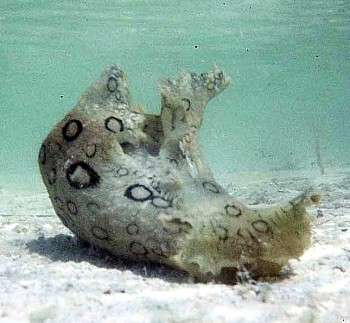
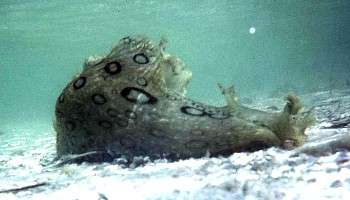
Dear Bill,
Here are some photos of the Spotted Sea Hare I photographed in Key West, Florida a few years ago, in about a foot of water.
Cordially,
Anne.
adupont@gate.net
Dupont, A., 1999 (Oct 15) Aplysia dactylomela from Florida. [Message in] Sea Slug Forum. Australian Museum, Sydney. Available from http://www.seaslugforum.net/find/1421Dear Anne,
Thanks very much. There is no mistaking the identity of Aplysia dactylomela, with its large black rings. I wish all the Sea Hares were so easy to identify. If by chance you have photos of Sea Hares, other than A. dactylomela and the one we are calling A. brasiliana, they could be useful for comparative purposes.
For that matter, if anyone has photos of Sea Hares from anywhere, they would be very welcome. It would be a lot easier trying to identify them if we had a better idea of colour variation within species.
Bill Rudman.
Sea Hares - Mass mortality in Florida
June 4, 1999
From: Annie Troutman
While vacationing in Pensacola, Florida this past weekend, I was shocked by the appearance of vast numbers of spotted sea hares or Aplysia dactylomela washed up on the shore. I understand they inhabit turtle-grass beds and sand flats, but I have never in my life seen any washed up on the shore. I gathered as many as I could, and put them in an area closer to the sound in an effort to save them. Anyway... any ideas as to what could have caused this?
Thanks for your time --
Sincerely,
Annie Troutman
Louisville, KY
a.troutman@mindspring.com
Troutman, A., 1999 (Jun 4) Sea Hares - Mass mortality in Florida. [Message in] Sea Slug Forum. Australian Museum, Sydney. Available from http://www.seaslugforum.net/find/919Dear Annie,
It seems to be a good season this year for Sea Hares in Florida. Have a look at the recent messages about the large numbers of swimming Sea Hares, which I have identified as Aplysia brasiliana, from Florida.
Sea Hares are often found aggregated in large numbers, often stranded and dying at low tide. Have a look at Cory Pittman's message and my answer, about the small Sea Hare Stylocheilus longicauda, where I discuss some of the ideas we have about these mass deaths in Sea Hares. Basically it seems that sometimes, when conditions are very favourable, large numbers of juveniles settle out of the plankton and grow rapidly to maturity (a bit like the 'baby boomer' generation after the Second World War). However at the inevitable dying end of the life cycle they all tend to die at the same time. This does not mean to say that there are not outside events which hasten the end. If these large populations coincide with periods of hot weather, relatively warm water and very low tides, death of intertidal animals, especially on broad sandflats, is often inevitable. At low tide exposed animals can be overheated and desiccated, and the returning sea water as the tide turns, rather then providing relief, brings water which has been heated and deoxgenated as it runs in over hot sandflats. In tropical waters I have measured sea water temperature rises of between 5-10 degrees C as the water runs in over heated sand.
In these cases I am afraid there is nothing much we can do. It is an unusual but natural phenomenon. For more general information on Sea Hares have look at the list of 'Sea Hare' topics in the GENERAL TOPICS index.
Best wishes,
Bill Rudman.
Aplysia dactylomela? from Bahamas
April 19, 1999
From: Troy Bartlett
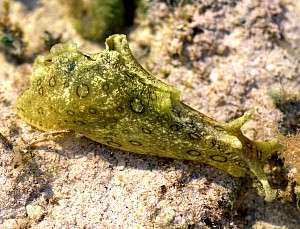
Hi,
First of all, what a wonderful resource this forum is. When I searched for information on sea slugs, I never imagined I'd find something as useful as this.
I'm writing because I took a picture of a sea hare while on a recent trip to the Bahamas and I was hoping to confirm it's ID.
The picture was taken on Grand Bahama island, Bahamas, near Deadman's reef, in a sandy tidal pool area. The water at the time was only a few inches deep.
I've posted the image on my website, including a high resolution image to aid identification (click on the normal size photo). http://troyb.com/photo/gallery/027-04-SpottedSeaHare.htm
From my research, I believe it to be Aplysia dactylomela. What I'm unsure about is if there are similar looking species and whether or not I can be reasonably sure that's what it really is.
Thanks in advance for the help,
Troy Bartlett
troy@troyb.com
Bartlett, T., 1999 (Apr 19) Aplysia dactylomela? from Bahamas. [Message in] Sea Slug Forum. Australian Museum, Sydney. Available from http://www.seaslugforum.net/find/792Dear Troy,
Your animal is definitely Aplysia dactylomela. It is one of the easiest of the Sea Hares to identify from the large black rings on both the inside and outside of the parapodia. In some cases the rings are smaller and the black quite thick but you can find all variations in a single population.
Usually the body, and parapodia, are thicker, and firmer, almost leathery to touch, than most species of Aplysia. Its wide circum-tropical distribution would suggest the species has been around a very long time. Another opisthobranch with a similar distribution is Hydatina physis
Best wishes,
Bill Rudman.
